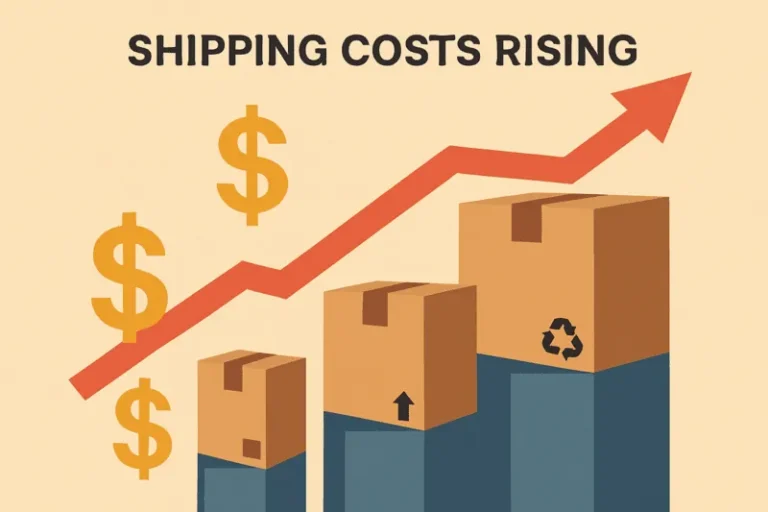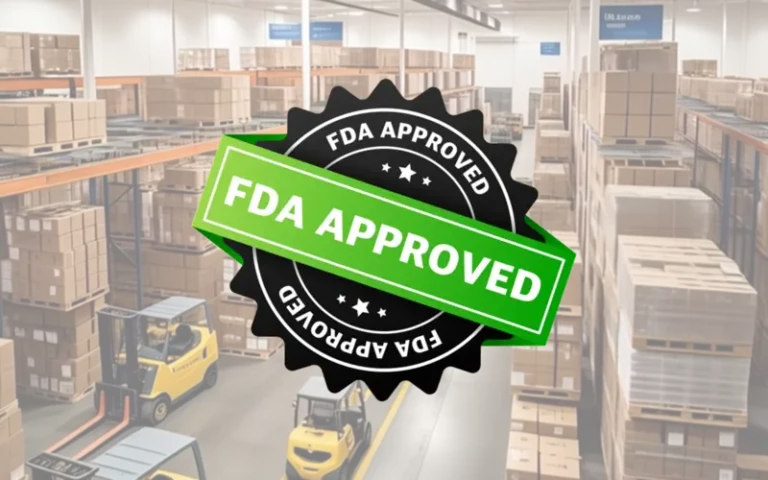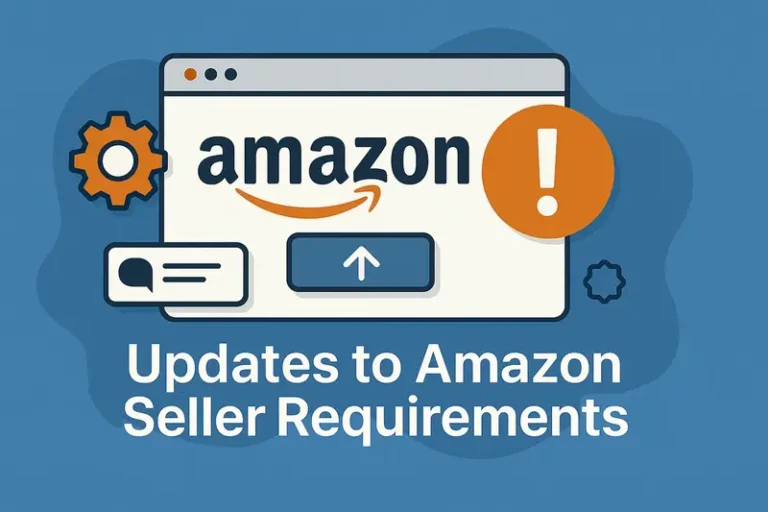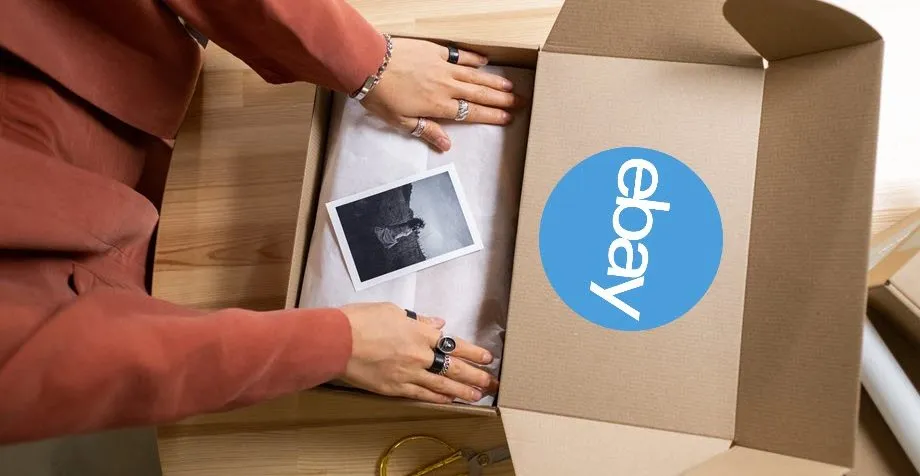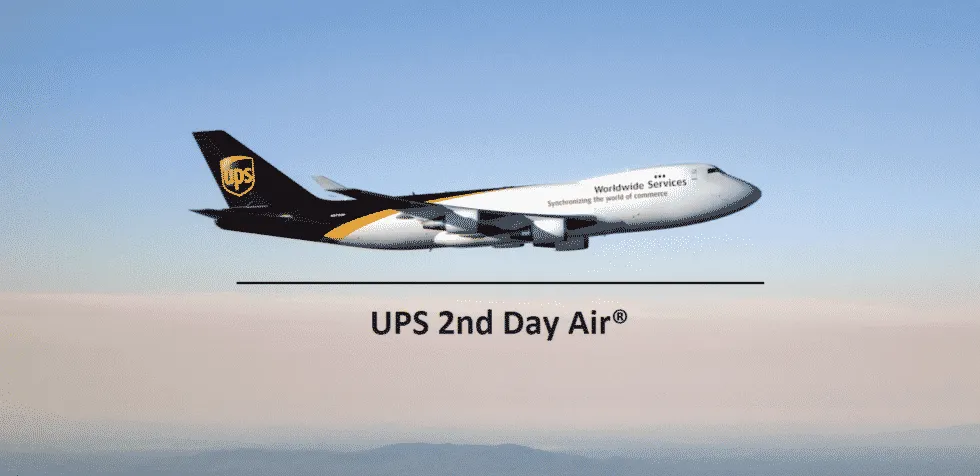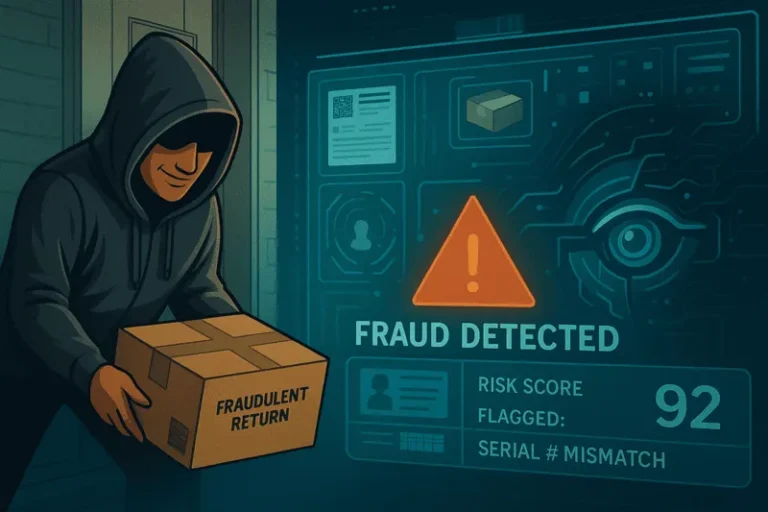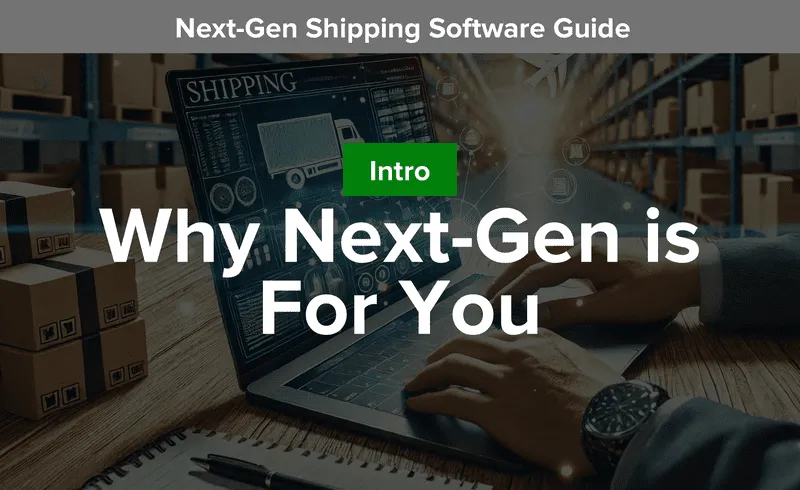The North Face Closes 113 Stores on Earth Day
In this article
The North Face closed it’s global headquarters and 113 stores in the U.S. and Canada on Earth Day, April 22. The action is part of a campaign to make Earth Day an officially recognized holiday.
The North Face closed it’s global headquarters and 113 stores in the U.S. and Canada on Earth Day, April 22. The action is part of a campaign to make Earth Day an officially recognized holiday.
As part of the campaign, the North Face also launched “Explore Mode” in major cities in the week leading up to Earth Day. Throughout the week, The North Face partnered with musicians, artists and culinary influencers to host a series of experiences that encourage people to disconnect digitally and engage with their surroundings.
Per Total Retail, The North Face joins a growing list of outdoor brands, including REI and Patagonia, that are becoming increasingly vocal about social causes such as environmental protection. For these companies, closing stores — costing short-term profits — has become a powerful tool to make a statement about serious global issues.
Offer 1-day and 2-day shipping at ground rates or less.
Related Blog Posts
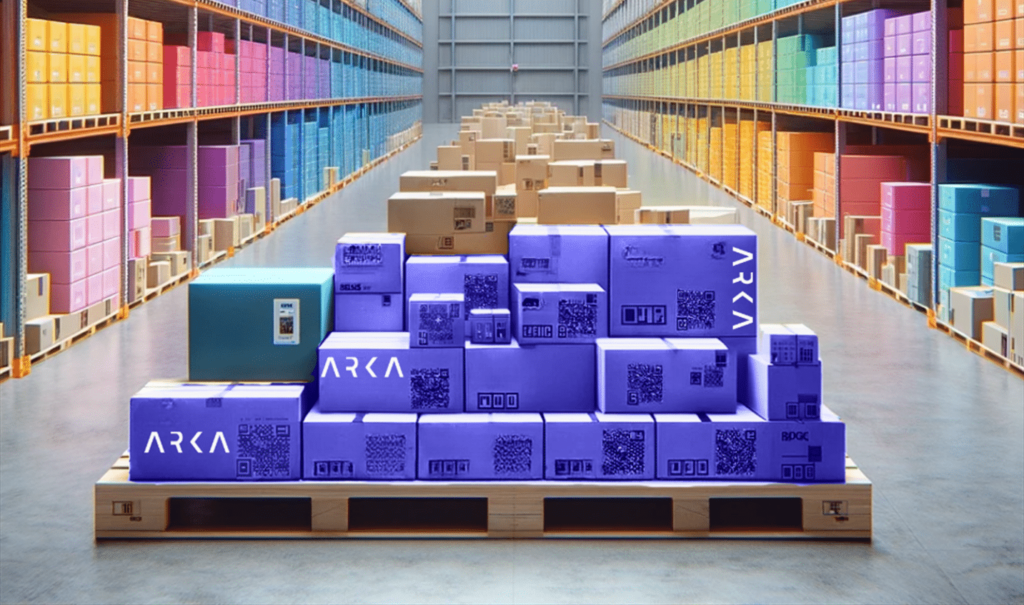
Packaging Design That Will Make Fulfillment Easy and Cut Costs
E-commerce Revolution with Strategic Packaging Solutions Like anyone in the e-commerce world, small business owners are always looking for ways to streamline their operations and

USPS Hazmat Shipping Guidelines – How to Ship Fast While Staying Compliant
Hazardous Materials What is a Hazardous Material? What Items Are HAZMAT? Classes of HAZMAT Items What Classes Can Ship on Various USPS Services? What Changes
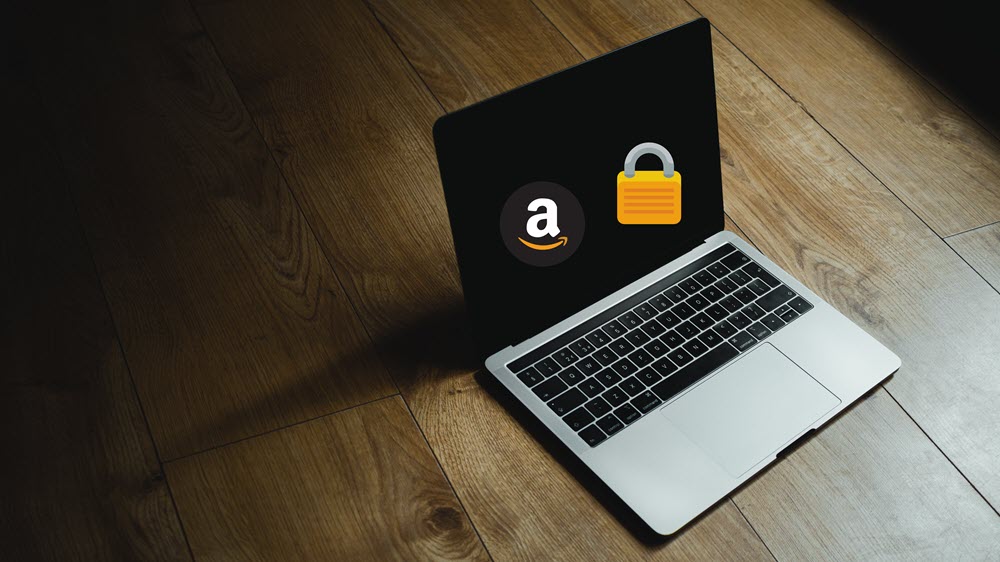
Protect Your Amazon Listings from Search Suppression, Hijackers, and Stockouts
Amazon is a competitive platform. You need to have a quality product, excellent listing content, and plenty of reviews to catch the attention of busy
Top 3 Alternatives to Amazon FBA
What’s not to love about Amazon FBA? List your product on Amazon, send them your inventory, and reap the rewards of the Amazon Prime badge and low shipping costs (though FBA fees are rising again).
It’s a great deal for those that can get it, but sellers need to be aware of rising FBA fees. It’s also limited in two key ways: 1) it’s an inflexible point solution and 2) Amazon simply doesn’t have enough space. And no wonder; Amazon adds about 3,700 new 3rd-party sellers a day, so FBA can’t keep up with demand. Amazon’s response is to limit FBA to work well only for the SKUs that maximize their profit (not the sellers’) and to impose restrictive inventory limits.
Sellers that want to grow both on and outside of Amazon will need an alternative to FBA to keep their growth engine humming. Read on to learn more about what to watch out for with Amazon FBA and your options for other ecommerce order fulfillment solutions.
Why You Can’t Rely on Just Amazon FBA
Amazon FBA will do a great job of fulfilling a portion of the volume of your small SKUs sold on Amazon, but it falls short otherwise.
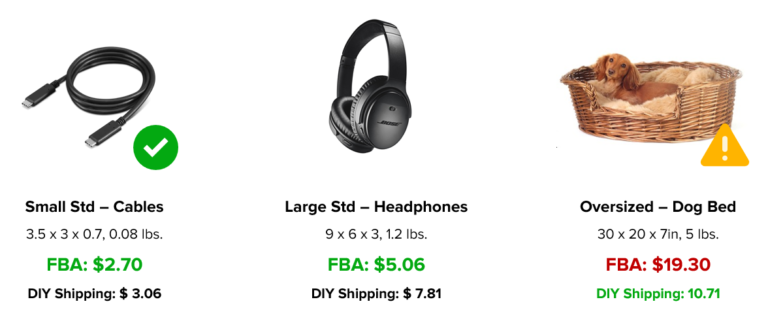
image courtesy: Amazon FBA Revenue Calculator, DIY Shipping estimated using discounted shipping rates for Zone 4 Residential shipping
The above example is typical of Amazon FBA fees: their price for small and standard items beats other options, but even slightly oversized products like the example 5lb dog bed ends up costing almost double a merchant’s price shipping it on their own. The reason is simple – they’ve optimized their network for small, easy, and efficient products.
As a result, Amazon sellers that use FBA for their shipping are boxed in when it comes to growth, and they all compete with one another to sell the same small, cheaper items. If FBA is your only good option, you can’t profitably expand your product line to larger, less competitive options because fulfillment fees will eat up your margins, making a 3PL a necessary consideration. If you raise price to compensate, then you’ll lose to the savvy merchants who have diversified their fulfillment strategies and can get the product to the customer at half the price.
The challenges don’t end there for Amazon FBA. ecommerce’s year over year unprecedented boom in growth has delivered massive returns to Amazon and Amazon sellers, but it’s also left FBA bursting at the seams. To compensate, Amazon switched from ASIN-level inventory limits to product type inventory limits and overnight sellers saw their inventory limits cut by up to 65%.
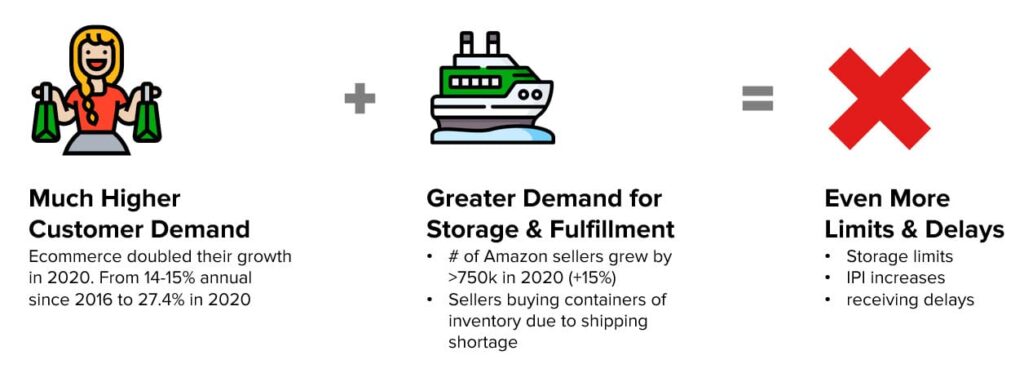
image courtesy: US Census Bureau, Marketplace Pulse, Cahoot interviews with merchants
On top of the lower limits, Amazon FBA is also experiencing receiving delays of up to three weeks. This creates a huge window of time in which a seller can run out of stock on a key item: even if the seller sent a timely replenishment, receiving delays can create the issue. In the peak selling season, this is an even bigger problem. Demand surges can easily run an item out of stock in a matter of days or even hours, triggering a death spiral in which a product loses its search rank, which lowers impressions and conversions, which in turn lowers inventory limit again.
It’s clear that Amazon FBA is no longer an all-in-one solution for Amazon sellers. It’s a point solution that can be an important part of a fulfillment strategy but needs to be augmented to cover for its flaws.
Evaluating Amazon FBA Order Fulfillment Alternatives
Amazon FBA’s structure tells a valuable, if simple lesson: the most cost-effective way to offer nationwide 1-day and 2-day delivery is to create a distributed fulfillment network that always has inventory near the end customer. This setup enables 1- and 2-day delivery with economic ground shipping; the best of both worlds.
To enjoy the same benefits of Amazon FBA’s network without the same drawbacks, sellers’ options generally fall into three main categories:
1. Open Multiple Fulfillment Centers Yourself
Merchants can take it upon themselves to open multiple US fulfillment centers, but today’s environment is extremely challenging. Warehouse space has never been more limited or expensive, and there are an incredible 400,000 open job positions for frontline ecommerce order fulfillment workers. On top of that, opening one’s own centers ties up significant capital and is risky – if a seller picks a sub-optimal location, or a location becomes sub-optimal as consumer preferences change, they’re stuck footing the bill.
2. Third-Party Logistics Companies (3PLs)
Another option is to outsource fulfillment to multiple 3PLs. These are generally smaller, independent companies not connected to any specific marketplace but 3PLs can offer comprehensive supply chain solutions. You will have to contract numerous 3PLs to get nationwide 1-day and 2-day coverage. Order routing across disparate 3PLs is complex and labor-intensive, so you may need to invest in expensive fulfillment software to make it more efficient. Fulfillment costs will vary between 3PLs, and not all of them can meet the strict SLAs needed to win the Buy Box on every marketplace, so be sure to use something like a 3PL request for proposal (RFP) template to get an apples to apples comparison.
3. Tech-enabled Fulfillment Network
A modern and affordable alternative to working with 3PLs is to use an ecommerce order fulfillment network. A tech-enabled fulfillment network upgrades the traditional 3PL model to cover the whole country. Merchants will send their inventory to multiple nodes in the network, and then the network’s software will automatically send parcels from the optimal location to the end customer, saving on shipping costs. In essence, these networks are “FBA-lite” – they have the same core functionality as FBA.
Definition of a Fulfillment Company
A fulfillment company is a third-party logistics (3PL) provider that specializes in managing the entire order fulfillment process for ecommerce businesses. They handle tasks such as inventory management, warehousing, order processing, packaging, and shipping. By outsourcing these logistics services, commerce businesses can focus on their core operations, such as marketing and product development, while the fulfillment company ensures that orders are processed efficiently and accurately.
Benefits of a Fulfillment Company in Ecommerce
In the ecommerce landscape, a fulfillment company plays a crucial role in providing efficient and cost-effective order fulfillment services to sellers. Acting as an extension of the ecommerce business, these companies manage logistics and supply chain operations, ensuring that customers receive their orders quickly and accurately. This allows ecommerce businesses to scale their operations without the burden of managing warehousing, packing, and shipping, ultimately enhancing customer satisfaction and operational efficiency.
Cahoot: Alternative to Amazon FBA
Cahoot is a robust FBA alternative, and it works just as well as a backup or enhancement of FBA as it does as a full replacement. And Cahoot’s much more than that; it’s the most flexible solution in the marketplace and can ship orders for every ecommerce sales channel.
Cahoot is the next generation of tech-enabled fulfillment networks. Unlike other networks that are collections of 3PLs, Cahoot’s innovative approach unlocks and empowers merchants across the country to fulfill orders for one another. Our peer-to-peer network is a collective of highly vetted ecommerce retailers who offer up excess warehouse space and resources to provide high-quality order fulfillment to other merchants.
As a result, costs are lower than what you get with a traditional 3PL fulfillment company, and service levels are higher. With a P2P network, multi-channel fulfillment with nationwide 1-day and 2-day delivery is the norm. Merchants can use the network solely for outsourced fulfillment, similar to FBA, or they can choose to fulfill orders for other merchants and offset some of their own outsourced fulfillment costs.
Frequently Asked Questions
What are the costs for FBA?
The main costs associated with Amazon FBA are fulfillment fees, storage fees (including aged inventory surcharges), and any extra charges for removal or disposal of inventory, inventory prep such as barcoding, placement fees, inbound defect fees, and possibly others. Make sure to factor these into your pricing strategy!
What is a 3PL?
A third-party logistics company (3PL) is a service provider that either arranges or handles a variety of supply chain functions for a business. These functions can include brokering, shipping, storing, or packing a company’s freight, as well as supply chain strategy and access to technology.
Is 3PL pricing more transparent?
3PL providers ensure transparent pricing by offering customizable logistics solutions and engaging in contract negotiations, which allows for clear and flexible pricing options. This way, you know exactly what you’re paying for and can budget accordingly.

Turn Returns Into New Revenue

eBay Fulfillment: How Fast Shipping Helps You Grow
In this article
 14 minutes
14 minutes
- What is eBay Fulfillment?
- Why is Fast and Free Shipping Important for eBay Fulfillment?
- Overview of Options for eBay Fulfillment Services
- Choosing the Right Fulfillment Service
- International Shipping and eBay Fulfillment
- Inventory Management and eBay Fulfillment
- Why Cahoot Is the Best Option for eBay Fulfillment
- Frequently Asked Questions
Fulfillment is often an afterthought for sellers – after all, “sellers” want to sell. Your eBay fulfillment strategy, though, has a much bigger impact on sales than you might realize. Utilizing an eBay Fulfillment Center, a comprehensive third-party logistics provider, can streamline order processing, manage inventory, and ensure timely deliveries, significantly enhancing customer satisfaction and business performance. If you’re not offering fast and free shipping, you’re severely limiting your growth. And if you don’t have the right provider, you’ll pay an arm and a leg for that shipping, eating up precious profits.
In this article, we’ll highlight the importance of fast and free shipping on eBay (if you’re not already convinced) and give a primer on your different options for eBay fulfillment. By the end, you’ll feel much more confident in your ability to turn operations into a growth driver for your business.
What is eBay Fulfillment?
eBay Fulfillment is a comprehensive service designed to help sellers outsource their order fulfillment processes to a trusted third-party logistics provider. This service allows sellers to focus on growing their business while leaving the logistics and shipping to a reliable partner. eBay Fulfillment centers offer a range of services, including storage, packing, and shipping, ensuring that orders are fulfilled quickly and efficiently. By leveraging an eBay Fulfillment service, sellers can significantly improve customer satisfaction, reduce shipping costs, and increase their overall profitability. With streamlined fulfillment processes, sellers can ensure that their customers receive their orders on time, every time.
Why is Fast and Free Shipping Important for eBay Fulfillment?
Online Shoppers Want Fast and Free Shipping
Thanks to Amazon Prime, online shoppers now expect their orders to arrive quickly and for free. In fact, a McKinsey study found that over 90% of customers view 2- to 3-day delivery as the baseline for eCommerce. eBay sellers used to be relatively immune from these rising customer expectations, but those days are over.
Ignore fast and free shipping at your own risk – US consumers expect free shipping even on orders under $50, and 48% of all cart abandonment is caused by unexpected shipping costs.
eBay now automatically applies “Free delivery in 2/3/4 days” tags to qualifying products – like the Fast ‘N Free badge that preceded it, this marker gives shoppers exactly what they want. eBay sellers with the tags stand out in search results and convert better, driving higher revenue by leveraging efficient shipping services that enhance order processing and customer satisfaction.
Improve your Seller Rating
Fast and free shipping is a key rating factor that can help to boost your eBay seller rating. Shipping time and shipping fees both have their own line item in “Detailed seller ratings” on eBay, and of course, a high seller rating has a huge impact on eBay sales. Having a reliable fulfillment partner is crucial for effectively managing shipping and logistics, ensuring timely delivery and high service standards.

Furthermore, qualification for the lucrative Top Rated Seller Program depends in part on fast shipping – so if you want to be in the top echelon of eBay sellers, you’re going to need fast and free shipping.
Increase Impressions
Free shipping helps you win more impressions and clicks on the eBay marketplace by providing actionable tips for sellers.
eBay gives users the ability to filter by “Free shipping”, meaning that if you’re charging for shipping, some buyers are completely excluding you from consideration. Even if they don’t filter out “Free shipping”, many others will sort their search results by “Price + Shipping” – that’s right; eBay’s price sort includes the cost of shipping, so if you undercut your competitor on product price, but have a shipping fee, you’ll still lose out.
On top of that, eBay prominently writes “Free shipping” for products that don’t charge for shipping, making them stand out against others that come with hefty shipping fees.

The combination of filters, sorts, and “Free shipping” copy all combine to make it an excellent way to boost your search page results on eBay.
Lower Cart Abandonment and Boost Conversion Rate
The impact of fast and free shipping isn’t limited to the product search experience. In truth, it makes the biggest difference once customers are on the product page itself. Consider that unexpected costs at checkout, including shipping, are the number one cause of abandoned carts, causing 48% of all shoppers to abandon.
Consumer preferences are clear – they convert more often and abandon their shopping cart less frequently when they’re offered free shipping. Effectively managing and fulfilling orders enhances efficiency in eCommerce, ensuring that customers receive their products quickly and reliably.
Improve Customer Lifetime Value
Shoppers will often go the extra mile for free shipping, which opens up creative strategies to boost your repeat purchase and retention rates.
Invesp found that 58% of customers will add items to a cart to qualify for free shipping, 47% will search for an online promo code, and 31% will join a loyalty program.
If you don’t want to offer free shipping right off the bat, then you can introduce an order value minimum or offer free shipping to people that sign up for a loyalty program. Both of these actions will improve your customer lifetime value – bigger carts are self-explanatory, and loyalty program members repeat shop again and again. An effective fulfillment strategy is essential for operating a profitable business, ensuring customer satisfaction and efficiency.
Overview of Options for eBay Fulfillment Services
So, you’re convinced – you want to offer fast and free shipping on eBay. But how do you do it without breaking the bank? Here are the pros and cons for the different ways you can fulfill orders.
eBay’s managed delivery service is an efficient logistics solution designed for sellers with high-volume inventory, aiming to provide faster delivery while reducing costs and complexities associated with order fulfillment.
Self fulfillment
eBay allows you to ship your items yourself. With in-house fulfillment, you own the process, the profits, and the risks.
The benefit, of course, is that you have full control over the fulfillment process. You can choose where and how your products are stored, ensuring that they’re in the best condition possible when they get to customers. If there are errors in fulfillment, you have the power to immediately fix issues.
The main drawbacks of self-fulfillment are that it’s extremely time-consuming and it isn’t cost-effective in the long run. If you’re fulfilling your own orders, your success comes with a price – more and more of your time will be consumed by managing operations.
If you’d like to learn more about how to go it alone, here’s a more in-depth look at how to offer free shipping and still make a profit.
Local pickup
This eBay fulfillment option is ideal if you sell large or bulky items. It allows you to arrange pickup with the buyer so you can avoid shipping costs and price your items even cheaper.
You’ll need to provide a ZIP code, at least one electronic payment method (in addition to Pay on pickup), customer service, and generate your Proof of pickup to protect yourself in case of “item not received” disputes.
Of course, local pickup limits your market to your locality or contiguous areas. Sellers with serious growth ambitions will need to combine local pickup with another fulfillment option.
Drop shipping
eBay sellers can also use drop shipping to fulfill orders directly from a wholesale supplier. Under this arrangement, your supplier will deliver orders directly to your customers.
Your supplier handles the entire fulfillment process on your behalf using the buyer information available to them. It’s simple and will dramatically reduce your overhead compared to self fulfillment. However, your customers will still hold you responsible for timely delivery and overall customer satisfaction. If the dropshipper makes a mistake, you’re the one that pays the price.
For quality, you don’t get to inspect the product before it gets to the customer. You have to rely entirely on the dropshipper, and when things go wrong, you’re left on the outside looking in.
Just as importantly, your customers won’t be delighted by fulfillment provided by dropshippers. Since they’re almost always shipping from one location, the delivery won’t be fast for customers across the country – and as we explained above, that’s a critical piece of modern eCommerce. Since they’re often shipping long distances, the shipping is more expensive than it needs to be as well.
If you choose this option, don’t list an item on eBay and then purchase it from another retailer or marketplace that ships directly to your customer. If you do, you’ll face sanctions ranging from listing cancellations to forfeiture of fees paid or payable to your account.
3PL fulfillment
If you’re looking for a fulfillment service that offers the benefits of self-fulfillment without all the hassle, then using a third-party provider is your best bet.
The best 3PLs will give you access to a nationwide network of warehouses and carriers, so shipping products will take less time than if you were going it alone – in most cases within one or two days. Furthermore, if a 3PL places your inventory across the country strategically, you’ll always pay ground rates for shipping, so fast delivery will come at low prices.
Like dropshipping, trusting a third party means giving up some control over your product before it gets to the customer. This challenge can become apparent with 3PLs that aren’t built for eCommerce, as products get damaged in their rush to fulfill orders. Modern 3PL networks that specialize in eCommerce, though, have very low defect rates and may even improve on your own delivery record. Multi channel fulfillment is also crucial, as it allows integration with multiple sales channels for efficient order management.
This can introduce complexity and increase your handling fees. A 3PL Request for Proposal can help you to weigh your options.
Choosing the Right Fulfillment Service
Choosing the right fulfillment service is crucial for eBay sellers who want to ensure that their orders are fulfilled efficiently and effectively. When selecting a fulfillment service, sellers should consider several key factors. First, evaluate the service’s reputation and reliability to ensure that it can consistently meet your fulfillment needs. Cost is another important consideration; look for a service that offers competitive pricing without compromising on quality. Additionally, seek out a fulfillment service that provides real-time inventory management, automated order tracking, and flexible shipping options. It’s also essential to consider the service’s ability to handle international shipping and its integration with the eBay platform. By choosing the right fulfillment service, sellers can enhance customer satisfaction, reduce shipping costs, and boost their overall profitability.
International Shipping and eBay Fulfillment
International shipping is a critical aspect of eBay fulfillment, as many sellers cater to customers around the globe. When choosing a fulfillment service, it’s important to find a provider that offers reliable and cost-effective international shipping options. A good fulfillment service should be capable of handling customs clearance, duties, and taxes, while also providing tracking and insurance options for international shipments. Additionally, the service should offer real-time updates on the status of international shipments, allowing sellers to keep their customers informed every step of the way. By using a fulfillment service that excels in international shipping, sellers can expand their customer base and increase their sales, all while ensuring a smooth and reliable delivery experience.
Inventory Management and eBay Fulfillment
Effective inventory management is a cornerstone of successful eBay fulfillment, ensuring that sellers have the right products in stock to meet customer demand. A top-notch fulfillment service should offer real-time inventory management, allowing sellers to track their stock levels accurately and avoid issues like overselling or underselling. The service should also provide automated alerts when stock levels are low, enabling sellers to replenish their inventory promptly. Additionally, a good fulfillment service will handle inventory storage, receiving, and picking, freeing up sellers to focus on growing their business. By utilizing a fulfillment service with robust inventory management capabilities, sellers can enhance customer satisfaction and reduce shipping costs, ultimately driving their business’s success.
Why Cahoot Is the Best Option for eBay Fulfillment
Cahoot’s eBay fulfillment service will power affordable fast and free shipping for your listings, increasing revenue and margin. Our best-in-class fulfillment network partners with eBay sellers to make fulfillment a breeze – we can get you up-and-running with an improved delivery experience in as little time as it takes you to send us inventory.
With Cahoot, your eBay store can integrate various fulfillment services directly, automating order processing, inventory management, and shipping logistics. Your listings will automatically get eBay 2-day, 3-day, and 4-day fast shipping tags (formerly Fast N’ Free Shipping), boosting conversion.

If you’d like to find out how Cahoot can help your business, please get in touch with us. We can’t wait to show you how fulfillment can power your growth on eBay.
Frequently Asked Questions
What is eBay fulfillment?
eBay Fulfillment refers to eBay’s logistics solutions that help sellers store, pack, and ship their products efficiently. Unlike Amazon’s Fulfillment by Amazon (FBA), eBay does not directly handle fulfillment but partners with third-party logistics providers to offer these services. One of the main programs currently available is eBay Fulfillment by Orange Connex, which provides warehousing, order fulfillment, and fast shipping options for eBay sellers.
Is selling on eBay worth it?
Selling on eBay can be worth it, but it depends on your business model, product type, and goals. eBay offers access to a massive global customer base, and (unlike Amazon) allows for both fixed-price listings and auction-style sales, which can help sellers move inventory quickly or get the best price for rare items. Fees are generally lower than Amazon’s, and there are fewer restrictions on the types of products you can sell.
However, there are challenges. eBay is highly competitive, with many sellers offering similar products, often at low margins. The platform has strict policies on seller performance, and negative feedback can impact sales. If you’re selling high-demand products and can manage fulfillment efficiently, eBay can be a profitable marketplace. However, if you’re looking for a fully automated fulfillment solution like Amazon FBA, eBay may require more hands-on effort.
How much does eBay make on each sale? (eBay fees)
Selling on eBay involves several fees that sellers should be aware of to manage their costs effectively. The primary fees include insertion fees and final value fees.
Insertion Fees: eBay allows sellers to list up to 250 items per month without incurring insertion fees. Beyond this allowance, each additional listing typically costs $0.35. However, certain categories may have different fee structures or exceptions.
Final Value Fees: When an item sells, eBay charges a final value fee, which is a percentage of the total sale amount, including shipping and handling. For most categories, this fee is 13.25% of the sale price up to $7,500 per item, and 2.35% on the portion of the sale over $7,500.
Can I sell on both Amazon and eBay?
Yes, you can sell on both Amazon and eBay at the same time. Many e-commerce sellers choose to list their products on both platforms to expand their reach and maximize sales. However, managing inventory, pricing, and fulfillment across two marketplaces requires strategic planning.
What is the best way to fulfill eBay orders?
The best way to fulfill eBay orders depends on your business size, volume, and resources. Options include self-fulfillment, local pickup, drop shipping, and using a third-party logistics (3PL) provider. Each method has its pros and cons, and the right choice will depend on your specific needs and goals.
How can I improve my eBay seller rating?
Improving your eBay seller rating involves several key factors, including providing fast and free shipping, maintaining accurate listings, offering excellent customer service, and promptly addressing any issues or disputes. Utilizing a reliable fulfillment service can help ensure timely deliveries and enhance customer satisfaction, which in turn can boost your seller rating.
What are the benefits of using a 3PL for eBay fulfillment?
Using a third-party logistics (3PL) provider for eBay fulfillment offers several benefits, including access to a nationwide network of warehouses and carriers, reduced shipping times and costs, and the ability to scale your operations without the need for significant investment in infrastructure. A 3PL can also handle inventory management, order processing, and shipping logistics, allowing you to focus on growing your business.

Turn Returns Into New Revenue

Related Blog Posts
The Ecommerce Merchant’s Guide to UPS 2nd Day Air
UPS offers a host of services to ensure that your packages are delivered quickly to customers. Small improvements in which service you pick can have a big impact on customer experience and profitability, so in this guide we’ll walk you through your options and how to make the right choice for your business.
What is UPS 2nd Day Air?
As customer expectations for fast shipping increase, services like UPS 2nd Day Air gain prominence. UPS 2nd Day Air is an alternative for businesses that require fast, but not overnight delivery. It’s simple – slow delivery speeds blunt online store growth because products with slow shipping are added to carts less frequently, and their carts are abandoned more often than products that ship quickly. A 2023 Hanover Research study found that 86% of online shoppers see 2- to 3-day delivery as the baseline, and 63% say they would switch retailers if they could not receive their items within this timeframe.
UPS 2nd Day Air is one of a few expedited shipping options from UPS, and they describe it as their “economical option for shipments that do not need overnight service”. Designed to meet domestic shipping needs across the continental United States and Puerto Rico, 2nd Day Air ensures that a package will arrive at its destination in two business days but the ‘type’ of 2nd Day Air you choose will affect the delivery time.
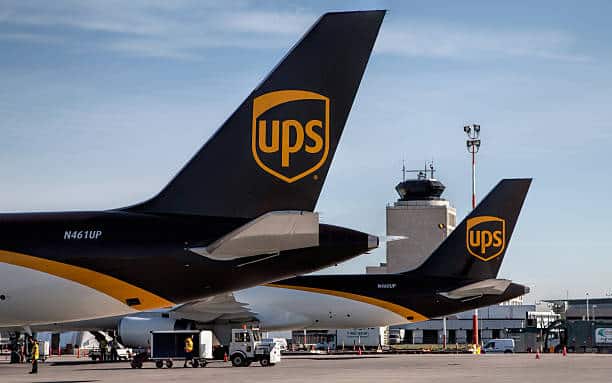
UPS 2nd Day Air provides day definite delivery; ensuring packages arrive within a specified timeframe. But there are two different types of 2nd Day service – standard service and AM. When someone absolutely needs an item first thing in the morning, you need to spring for the much more expensive 2nd Day Air AM. Without 2nd Day Air AM, UPS only guarantees an end-of-day delivery time, which can of course stretch late into the night.
In addition to 2nd Day Air, UPS also offers 1-day and 3-day expedited services. The 1-day service is called UPS Next Day Air, and as you can imagine the 3-day service is called UPS 3 Day Select.
Benefits of Using UPS 2nd Day Air
UPS 2nd Day Air is a popular shipping option for businesses that need to deliver products quickly and efficiently. Here are some benefits of using UPS 2nd Day Air:
- Fast Delivery: UPS 2nd Day Air guarantees delivery by the end of the second business day, making it an ideal option for businesses that need to deliver products quickly. This ensures that your customers receive their orders promptly, enhancing customer satisfaction and loyalty.
- Cost-Effective: Compared to overnight shipping, UPS 2nd Day Air is a more cost-effective option. It allows businesses to save on shipping costs while still providing expedited delivery. This balance between speed and cost can be crucial for maintaining profitability in a competitive market.
- Reliable: With UPS 2nd Day Air, you get the peace of mind that comes with guaranteed delivery. UPS guarantees delivery within two business days, ensuring that your packages arrive on time and reducing the risk of delays that could impact your business operations.
- Flexible: UPS 2nd Day Air offers a range of shipping options to meet different needs. Whether you require morning delivery, afternoon delivery, or residential delivery, UPS has you covered. This flexibility allows businesses to cater to various customer preferences and special delivery instructions, enhancing the overall shopping experience.
UPS 2nd Day Air Delivery Times
UPS 2nd Day Air delivery times vary depending on the destination and the time of day the package is shipped. Here are some general guidelines for UPS 2nd Day Air delivery times:
- Business Days: UPS 2nd Day Air delivery times are based on business days, which are Monday through Friday and do not count the date of shipment. This means that packages shipped on a Friday will typically be delivered by the end of the day on the following Tuesday.
- Delivery Begins: Delivery begins at 10:00 am, and the first packages are typically received by 10:30 am. This early start ensures that businesses can receive their shipments promptly and begin processing them without delay.
- Afternoon Delivery: For those who prefer later delivery times, UPS 2nd Day Air offers afternoon delivery, with packages typically arriving by 4:30 pm. This option is ideal for businesses that operate later in the day or for customers who are not available in the morning.
- Residential Delivery: UPS 2nd Day Air also caters to residential delivery needs, with packages typically arriving by 7:00 pm. This ensures that customers who are not home during the day can still receive their packages in the evening.
Overall, UPS 2nd Day Air is a reliable and cost-effective shipping option that offers fast delivery times and flexible shipping options. Whether you need to meet tight deadlines or provide convenient delivery times for your customers, UPS 2nd Day Air has the solutions to meet your needs.
How Much Does Shipping UPS 2nd Day Air Cost?
Cahoot’s internal shipping metrics show that UPS 2nd Day doesn’t come cheap – in fact, we observe that it’s often roughly two times as expensive as UPS Ground.
If you’re used to paying $8 or $9 to ship your packages via Ground and seeing them take a week to deliver, 2-day delivery is going to cost you somewhere in the upper $10 dollar range. In the hyper-competitive ecommerce world, an extra $5-10 in shipping costs can often be the difference between making and losing money on an order.
UPS 2nd Day Air AM balloons the cost of shipping far beyond the standard version of 2-day. Our data shows that the AM option nearly doubles the cost of standard – so it often comes in at nearly 4 times more expensive than UPS Ground. To us, the small added benefit of an early delivery won’t often justify the large added cost.
How to Ship Fast Without UPS 2nd Day Air
To quickly recap – customers expect fast shipping, so you need to offer it to boost growth. However, fast shipping is prohibitively expensive. If you’re like the vast majority of ecommerce merchants and can’t eat $10 extra in shipping on every single item, you need a better way.
The solution to this riddle is to ensure that you always have inventory close to the customer so that UPS Ground delivers in 1- to 2-days without the extra cost of 2nd Day Air – many call this a “distributed fulfillment strategy”. Typically, this means ensuring that you never ship farther than Zone 4, and it requires ~4 fulfillment locations strategically placed throughout the United States. This simple principle, though, is anything but simple in execution.
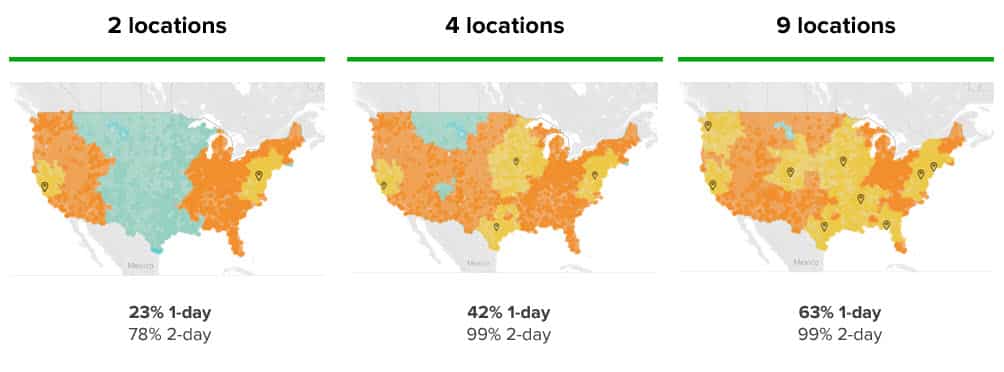
Here’s the three ways that merchants can adopt a distributed fulfillment strategy:
- Open Multiple Fulfillment Centers: merchants can open multiple US fulfillment centers and manage the four walls themselves. While having control may seem appealing, there’s never been a worse time to try to stand up merchant-operated fulfillment. Warehouse rents are hitting record highs, and if you can even find people to work for you, you’ll have to pay them $29.00 per hour to compete with Amazon’s rates. This strategy is also time-consuming and risky – you’ll spend countless managerial hours on operations instead of selling, and you’ll have to tie up significant capital.
- Marketplace Fulfillment Services: Amazon and Walmart offer their own in-house fulfillment networks; Amazon FBA and Walmart Fulfillment Services, for sellers on their platform. They enable fast shipping nationwide, and crucially, they allow vendors to place Prime Badges and Walmart TwoDay tags on their listings to boost visibility and conversion. While attractive, these solutions come with significant drawbacks. They’re designed for small products, so FBA is much more expensive for large items, while Walmart doesn’t accept them at all. Additionally, they’ll only solve your fulfillment needs for the marketplace itself. Amazon FBA’s multi-channel solution, Amazon MCF, is significantly more expensive than FBA, while WFS only works for Walmart orders.

- Third-Party Logistics Companies (3PLs): Your last option is to outsource fulfillment to one 3PL with national fulfillment services, or to multiple single-location 3PLs. The best 3PLs will have 10 or more locations across the United States, so they can strategically place your inventory right near your customer base. Modern 3PLs designed for ecommerce also have built native integrations with all major marketplaces and shopping carts, so you can use one provider for all of your fulfillment needs. Fulfillment costs will vary between 3PLs, though, and not all of them can meet the strict SLAs needed to win the Buy Box on every marketplace. Be sure to use something like a 3PL request for proposal (RFP) template to get an apples to apples comparison.
Cahoot Enables 2-day Shipping at Ground Rates
Cahoot’s nationwide network of over twenty warehouses provides affordable national ecommerce order fulfillment for ecommerce merchants. Thanks to our dense network, we’ll strategically distribute your inventory so that you reach 99% of the country in 2 days but always pay low ground rates.
Unlike other providers, Cahoot has the flexibility to upgrade existing merchant-owned warehouses (if you have them). We’ll analyze your existing network and customer base, then add a few locations of our own to seamlessly extend your network into a nationwide footprint. With this approach, you can continue to get value out of your existing assets while delighting your customers and your bottom line with affordable fast shipping.
Getting started with Cahoot is fast and easy – with pre-built integrations for major ecommerce channels like Amazon, Walmart, Shopify, and BigCommerce, we can get merchants started in as little time as it takes to send us your inventory.
Talk to one of our experts today and explore how we can be the key that unlocks the next level of your profitable ecommerce growth.
Frequently Asked Questions
What is UPS 2nd Day Air?
UPS 2nd Day Air is a shipping service that guarantees delivery within two business days.
What Does 2 Business Days Mean?
UPS counts standard week days as a business day. This means a package picked up on Friday will deliver by Tuesday end of day.
What is the Package Weight or Size Limit?
UPS 2nd Day Air shipments must be 150 lbs or less. Packages should be no more than 119 in long or 165 in combined length plus girth dimensions.
Does UPS 2nd Day Air offer Saturday Delivery?
UPS 2nd Day Air offers Saturday delivery if packages are picked up on Thursday by UPS.

Turn Returns Into New Revenue

Related Blog Posts
The Best Way to Ship Heavy Items: How to Maximize Your Profit
If you’re shipping large items, then you know the pain of high storage, handling, fulfillment, and especially shipping costs eating up your margin. While you’ll always pay more to ship a chair than a pen, you shouldn’t resign yourself to eating sky-high rates. With higher shipping costs come larger opportunities to save money; cutting a few dollars of cost off of each order goes straight to your bottom line.
In this article, we’ll cover three of the top ways that you can reduce your cost while shipping heavy and/or large items. Implement them and watch your profit jump and headaches melt away!
Understanding Heavy Item Shipping
Heavy item shipping refers to the transportation of goods that exceed standard weight and size limits. These items require specialized handling, equipment, and logistics to ensure safe and efficient delivery. Whether you’re shipping industrial machinery, medical equipment, or large furniture pieces, understanding the nuances of heavy item shipping is crucial for minimizing costs and maximizing efficiency.
Heavy vs Large Packages
First, we need to make a distinction between heavy and large items. Often large items are heavy, and heavy items are large, but that’s not always the case. When you ship heavy packages, it’s crucial to understand the specific rules, limitations, and pricing options of different carriers to ensure shipping cost-effectiveness and compliance. Improper shipping and handling can also include additional surcharges, double penalizing shipping heavy items. Shipping carriers have specific guidelines and weight thresholds that classify items as heavy, and understanding these definitions can help you choose the right shipping method and carrier.
Definition of Heavy Items in Shipping
Carriers define packages as Heavy if the package weighs more than their normal weight range. For example, UPS charges additional fees for packages weighing more than 70 lbs (31.75 kg), and their maximum allowed parcel weight is 150 lbs.
Definition of Large Items in Shipping
Carriers define packages as Large if the package’s size is more than their normal allowed size range. For example, FedEx’s Large package size starts at a girth greater than 130 inches, and their maximum allowed package length + girth is 165 inches.
Types of Heavy Items
Heavy items typically include furniture, machinery, tools, and other items made of wood or metal. These are typically bulky goods that require special handling and care.
Importance of Proper Shipping for Heavy Items
Proper shipping of heavy items is crucial to ensure safe and efficient delivery. Improper handling and transportation can result in damage to the goods, injury to handlers, and increased shipping costs. Choosing a reliable shipping carrier that specializes in heavy item shipping and follows strict safety protocols is essential. By investing in proper packaging, using heavy-duty packing tape, and selecting the right shipping method, you can minimize risks and ensure your heavy items reach their destination in perfect condition.
Freight (LTL) Shipping Options
Freight shipping is a cost-effective way to transport heavy items over long distances. There are several freight shipping options available, each offering unique benefits and services tailored to meet the needs of shipping large and heavy items. For items that are too heavy to ship via parcel, freight shipping is the best option.
Overview of Freight Shipping Services
Freight shipping services offer a range of benefits, including:
- Cost-effectiveness: Freight shipping is often cheaper than parcel shipping for heavy items. By consolidating shipments and using specialized equipment, freight carriers can offer competitive rates for transporting large and heavy items.
- Flexibility: Freight shipping services can accommodate a wide range of goods, including oversized and heavy items. Whether you’re shipping machinery, equipment, or furniture, freight carriers have the expertise and resources to handle your shipment.
- Reliability: Freight shipping services provide tracking and monitoring to ensure safe and efficient delivery. With advanced logistics and real-time tracking, you can stay informed about the status of your shipment and ensure it arrives on time.
Some popular freight shipping services include:
- DHL Freight: Offers a range of freight shipping services, including ocean freight and air freight. DHL Freight specializes in international shipping and provides comprehensive solutions for transporting heavy items across borders.
- UPS Freight: Provides freight shipping services for heavy items, including machinery and equipment. UPS Freight offers a variety of shipping options, including LTL (less-than-truckload) and FTL (full-truckload) services, to meet your specific needs.
- FedEx Freight: Offers freight shipping services for heavy items, including furniture and oversized goods. FedEx Freight provides reliable and efficient shipping solutions, with options for expedited and standard delivery.
When shipping heavy items, it is essential to choose a reliable freight shipping service that meets your specific needs and budget. Be sure to compare shipping rates, weight limits, and express services to find the best option for your heavy item shipping needs. By selecting the right freight carrier, you can ensure your heavy items are transported safely and cost-effectively.
Distribute Inventory to Reduce Shipping Zones
To state the obvious, the farther you’re sending a package, the more you’ll be charged. Within the continental United States, shipping distance is governed by Zones. Short trips will be designated Zone 2, while shipping something across the country will usually be designated Zone 8.
If you’re fulfilling out of just one warehouse, you have no choice but to routinely ship to Zones 5 and up, which is especially costly with large or heavy packages. Even with two warehouses, much of the country will be outside of the low-cost Zones 2 & 3.
The simple trick is to ensure that you always have inventory close to the customer so that every shipment originates from Zone 4 or less; many call this a “distributed fulfillment strategy”. It requires 3 to 4 fulfillment locations strategically placed throughout the United States. Cutting your average shipped-to zone will drive savings straight to your bottom line.
Distributed fulfillment also comes with the enormous added benefit of enabling fast ecommerce order fulfillment – after all, if your product isn’t shipping far, then it won’t take more than 1 or 2 days to get to the customer. You can stop worrying about using extremely expensive services such as UPS 2nd Day Air and pay ground rates for customer-pleasing fast delivery.
This simple principle, though, is anything but simple in execution.

Based on Ground Shipping speeds
If you already have one warehouse, then it can be tempting to take it upon yourself to open 1-2 more US fulfillment centers across the country. While maintaining control of your customer experience is appealing, there’s never been a worse time to try to stand up merchant-operated fulfillment. Warehouse rents are at record highs, and Amazon has pushed the cost of labor as high as $29.00 per hour.
If you’re a marketplace seller, then you may already be using Amazon and Walmart’s in-house fulfillment networks; Amazon FBA and Walmart Fulfillment Services. These services will solve the distributed inventory challenge for you and enable fast shipping, but they also come with significant drawbacks. They’re designed for small products, so they both significantly raise prices for large items. Walmart, for instance, charges all items with a side length of over 96 inches or a combined length and girth over 130 inches as at least 90 lb no matter their actual weight, and then they add a $25 surcharge to boot. Additionally, they’ll only solve your fulfillment needs for the marketplace itself. Amazon FBA’s multi-channel solution, Amazon MCF, is significantly more expensive than FBA, while WFS only works for Walmart orders.
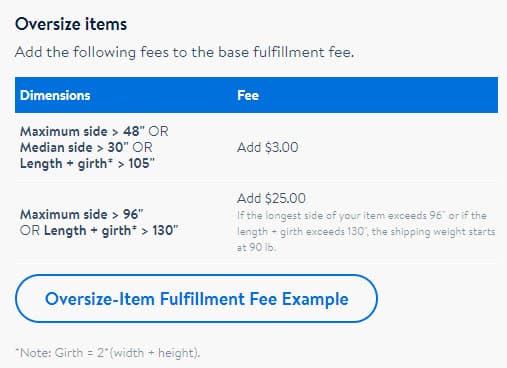
Your last option is to outsource fulfillment to one 3PL with national fulfillment services, or to multiple single-location 3PLs. The best 3PLs will have 10 or more locations across the United States, so they can strategically place your inventory in the perfect position for your customer base. Modern 3PLs designed for ecommerce also have built native integrations with all major marketplaces and shopping carts, so you can use one provider for all of your fulfillment needs. Fulfillment costs will vary between 3PLs, though, and not all of them can meet the strict SLAs needed to win the Buy Box on every marketplace. Be sure to use something like a 3PL request for proposal (RFP) template to get an apples to apples comparison.
Ship Heavy Items with the Right Carrier
Not every carrier is created equal when it comes to shipping heavy items, and relatively small adjustments in your package size and weight can have big implications when it comes to choosing the most cost-effective option.
FedEx’s guidelines on how to ship oversize items detail that they add an oversize shipping fee when packages have a girth of more than 130 inches. Note that if a package is over 150 lbs, or if its combined length and girth is more than 165 inches, then FedEx will classify it as freight and apply a completely different set of rules.
UPS governs its large items a bit differently. It will designate a package as “Over Maximum Size” when its length plus girth combined exceeds 165 inches, and charge additional fees. UPS charges additional fees for packages over 70 lbs and has a maximum package weight is 150 lbs.
Finally, USPS is less equipped to ship large packages, and thus has more restrictive rules. Their maximum size for most mailpieces is 108 inches in combined length and girth, but USPS Retail Ground has a slightly larger allowance of 130 inches. Regardless of size, the maximum mailable weight of any mailpiece sent through USPS is 70 lbs. Packages that are between 108 and 130 inches in combined length and girth are subject to a special oversized price on USPS.
These guidelines leave wiggle room for savvy merchants to optimize their shipping costs. Note that FedEx’s oversize charge only kicks in on packages with a girth of more than 130 inches, while UPS and USPS have lower limits. On top of that, the latter two’s limits are based on combined length and girth. If your package fits under FedEx’s bar for oversize, but over the bars for the other carriers, then you know that you can avoid surcharges by shipping with FedEx.
You can take it upon yourself to negotiate with the carriers separately, or if you’re using shipping software like ShipStation, you can set manual rules and rate shop to scrutinize your orders for the best rates. On the other hand, our next-gen shipping software will do the hard work for you by automatically comparing major and regional carriers against each other for each order. Without any manual intervention, the software will take quirks like differences in surcharges into account and ensure that you’re getting the best deal, every time.
Optimize Package Size
Small changes in package size can make a big difference to your final shipping cost. When you’re shipping large and oversize items, every additional pound usually adds $0.30 – $0.50 to your cost, which adds up quickly!
Package size matters because of Dimensional Weight, or DIM weight for short. Major carriers introduced DIM weight around 2015 as a way to charge more for bulky, yet light products. The calculation is fairly simple: DIM weight is equal to L x W x H of your package, divided by 139 (166 for USPS). If the resulting number is larger than the weight of the package in pounds, then the shipping weight used to calculate price will be elevated to the DIM weight.

In this way, inefficiencies in package design quickly add up to boost your shipping cost to well more than it should be.
Consider a package that is 24 x 24 x 24. This 2 ft cube package’s DIM weight is 99.45 lbs. If you’re shipping two pillows in that package, the actual weight is probably less than a tenth of the DIM weight. In that scenario, DIM weight increases your cost by $30 or more! What if you could shave 4 inches off one of the sizes by more efficiently compacting your pillows?
Those 4 simple inches cut the DIM weight all the way down to 82.88 lbs, a nearly 20% reduction. That package would fall into FBA’s “Medium oversize” category, with a shipping weight between 70 – 150 lbs. FBA’s fulfillment fee rises by $0.44 for each pound in that category, so shaving the 4 inches off of one side of the package would save you over $7 per order.
Cahoot Ships Heavy Items at Low Cost
Cahoot’s nationwide network of over a hundred warehouses provides affordable national ecommerce order fulfillment for ecommerce merchants.
We cover each of the three key pillars of reducing the shipping cost of heavy items for you:
- We’ll strategically distribute your inventory to 4+ locations
- Our next-gen shipping software automatically finds the lowest cost shipping label that meets your delivery SLA
- We work with you to shrink package size
Unlike other providers, Cahoot also has the flexibility to work alongside existing merchant-owned warehouses (if you have them). We know that many merchants with oversize goods carefully manage fulfillment themselves due to how difficult the process can be. Cahoot will analyze your existing network and customer base, then add a few locations of our own to seamlessly extend your network into a nationwide footprint.
With this approach, you can continue to get value out of your existing assets while delighting your customers and your bottom line with affordable fast shipping.
Getting started with Cahoot is fast and easy – with pre-built integrations for major ecommerce channels like Amazon, Walmart, Shopify, and BigCommerce, we can get merchants started in as little time as it takes to send us your inventory.
Talk to one of our experts today and explore how we can be the key that unlocks the next level of your profitable ecommerce growth.
Frequently Asked Questions
What is the cheapest way to ship heavy items?
This depends on the size of the item. For smaller items, USPS Priority Mail can be cost effective, and for larger items, UPS or FedEx is usually cheaper.
Are there any special instructions when shipping heavy items?
Heavy items can do more damage when moving in transit; proper packaging and dunnage help keep heavy items protected in shipping.

Turn Returns Into New Revenue

New Amazon FBA Holiday Order Fulfillment Fee Squeezes Seller Margins
It has been a difficult year filled with price increases for Amazon sellers that rely on Fulfillment by Amazon (FBA), and it’s about to get even more difficult.
On August 16th, Amazon announced that for the first time ever, they will implement a Holiday Peak Order Fulfillment Fee to take effect from October 15th, 2022 to January 14th, 2023. Per Amazon, the fee will be an average of USD 0.35 per item sold using US and Canada FBA. Even in isolation, a 35 cent increase in fulfillment fees can be difficult for sellers to absorb. Considering the enormous pressure that inflation is already putting on sellers and other FBA price increases, this could be the straw that breaks the camel’s back.
How has Amazon ratcheted up the price pressure on FBA sellers this year, and what can sellers do to fight back and protect their margins?
Amazon FBA Price Increases in 2022
Amazon has raised prices across the board for FBA sellers multiple times in 2022. How do they add up?
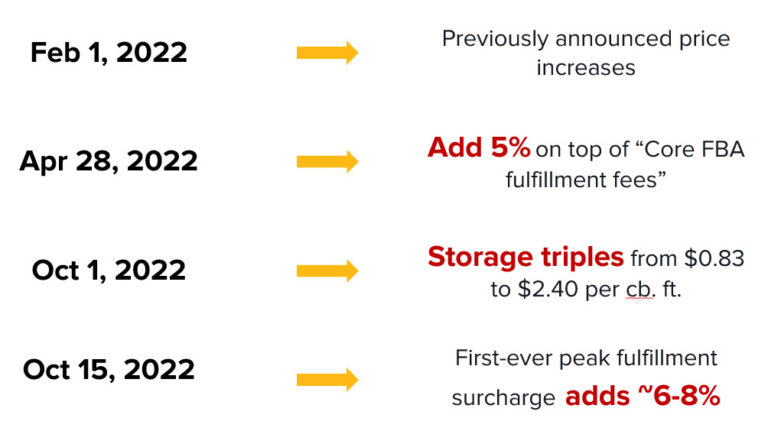
Source: Amazon Seller Central, Cahoot analysis
Annual Amazon FBA Fee Increase
It started with annual FBA fee increases that kicked in on February 1st. Order fulfillment fees increased from 2% on the low end to as much as 12% on the high end. Sellers with items in the Small Standard categories saw increases of 8%, or $0.22 to $0.27. For small products selling under $20 or even $10, this immediately shaved off a few points of margin.
On top of that, FBA Storage Fees increased by $0.08 per cubic foot, or 10.6%. Again, this increase can shave off a point or two of margin, making enduring profitability that much more difficult.
Finally, Amazon increased Removal and Disposal Fees by over 100% for many items. For instance, a SKU between 1-2 lbs will increase from $0.35 to $0.75. Sellers don’t usually plan on having to pay for removal, but nevertheless some products will fail to sell and need to be liquidated – especially in the cutthroat environment of Amazon’s 3P marketplace. This change raises the overall cost of doing fulfillment business.
Amazon Fuel and Inflation Surcharge
Just two months later, Amazon added a 5% “fuel and inflation surcharge” on top of the previously announced price increases. This kind of surcharge was a first for Amazon, and like the previous changes it adds another ~20 to 50 cents in cost to most items. Taken together with the Q1 increases, by this point FBA had already added a dollar or more to total fulfillment costs for many items.
Amazon Holiday Peak Order Fulfillment Fee
The new fee in question, the Holiday Peak Order Fulfillment Fee, will be applied on top of both of the February price increases and the Fuel and Inflation Surcharge. It will be in effect from October 15th of this year to January 14th in 2023, so for the entirety of peak.
At an average of another 35 cents on top of the other increases, there are few, if any, items that haven’t shot up over a dollar in cost to fulfill through FBA this year. When you consider that many smaller items only cost $3 or $4 to fulfill through FBA, that’s a staggering 25%+ increase in one of the most important operational costs in one year. Sellers with small, $10 items have now likely seen over 10% more of their revenue disappear in FBA fees in just over half a year. That, unfortunately, is fatal to most sellers.
The Top Amazon FBA Alternative: Cahoot FBM
Cahoot has created an Amazon-like ecommerce order fulfillment services network that makes low cost, fast and free shipping a breeze for every eCommerce sales channel – including Amazon FBM.
Cahoot is the next generation of tech-enabled order fulfillment networks. Unlike other networks that are collections of third party logistics warehouses (3PLs), Cahoot’s innovative approach empowers merchants across the country to fulfill orders for one another. Our peer-to-peer network is a collective of highly vetted eCommerce retailers who offer up excess warehouse space and resources to provide high-quality order fulfillment to other merchants. Since they fulfill their own DTC orders, they know how important top-notch fulfillment is, and they put the same care and energy into your orders as they do for their own.
Because Cahoot is leveraging excess capacity in merchant-owned warehouses, we’re less pressured by rising warehouse and labor costs than Amazon is. As a result, costs are typically lower than what you get with a traditional 3PL fulfillment company. With a P2P network, multi-channel fulfillment with nationwide 1-day and 2-day delivery at economy shipping rates is the norm.
Still unconvinced? Here’s a deep dive into how you can make the choice between Amazon FBM vs FBA – or decide to use a mixed strategy.
Offer 1-day and 2-day shipping at ground rates or less.
Related Blog Posts
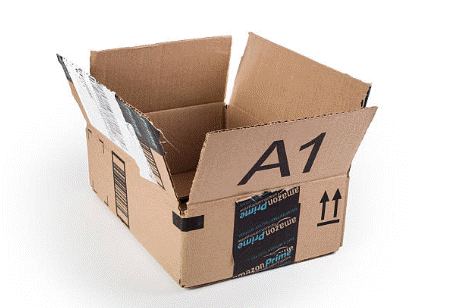
Amazon FBA Grade and Resell: Program Benefits and Pitfalls
Ecommerce returns are painful for Sellers no matter which way you slice it. They drain attention and resources and directly impact the bottom line.

USPS Hazmat Shipping Guidelines – How to Ship Fast While Staying Compliant
Hazardous Materials What is a Hazardous Material? What Items Are HAZMAT? Classes of HAZMAT Items What Classes Can Ship on Various USPS Services? What Changes

Protect Your Amazon Listings from Search Suppression, Hijackers, and Stockouts
Amazon is a competitive platform. You need to have a quality product, excellent listing content, and plenty of reviews to catch the attention of busy

Turn Returns Into New Revenue

Amazon Market Research: How Data-Driven Decisions Increase Online Profits
In this article
 11 minutes
11 minutes
- Understanding the Amazon Marketplace
- Market Size and Growth
- The Foundation of Successful Amazon Selling
- The Benefits of Market Research
- Understanding Market Trends
- Product Research: Finding Profitable Products
- Analyzing Customer Feedback
- Product Selection and Sourcing
- Optimizing Product Listings
- Marketing and Promotion Strategies
- Minimizing Risks
- Conclusion
In the vast and competitive world of ecommerce, staying ahead of the game is essential for business success. Whether you’re a seasoned Amazon seller or just starting out, one of the most valuable strategies you can adopt is investing in thorough market and product research. This investment can significantly boost your online profits and help you make informed decisions about which products to sell and how to sell them. In this comprehensive guide, we will explore the importance of market and product research on Amazon and how effective Amazon product research strategies can maximize your return on investment (ROI).
Understanding the Amazon Marketplace
Amazon is the world’s largest online marketplace, offering an extensive range of products to consumers across the globe. This immense platform presents both opportunities and challenges for sellers. To succeed, you must first understand the dynamics of the Amazon marketplace:
- Competition: Amazon hosts millions of sellers, and each product category is highly competitive. Know your competition in order to carve out your niche effectively.
- Consumer Behavior: Amazon’s search algorithm, A9, determines product rankings based on various factors, including customer reviews, keywords, and sales history. Understanding how customers search for products can help you optimize your listings.
- Fulfillment Options: Amazon offers different fulfillment methods, such as Fulfilled by Amazon (FBA) and Fulfilled by Merchant (FBM). Each has its pros and cons, and your choice can impact your profit margins.
- Pricing Strategies: Dynamic pricing is common on Amazon, so keep an eye on your competitors’ pricing strategies and adjust yours accordingly.
- Reviews and Ratings: Positive reviews and high ratings can boost your product’s visibility and credibility, increasing sales.
Another valuable resource for Amazon sellers is the Amazon Product Opportunity Explorer tool. This tool helps identify new product ideas by allowing sellers to search for relevant niches and access key metrics like customer needs and search volume, which aid in making informed decisions and reducing the risk of product failure.
Market Size and Growth
Understanding Amazon’s market size and growth helps make informed decisions about your product offerings. Amazon’s net revenue has seen a consistent upward trajectory, reaching an impressive $638 billion last year. Projections suggest this figure will continue to rise 5 – 9% per quarter, driven by the ever-increasing demand for online shopping, the expansion of Amazon’s product range, and strategic acquisitions.
To gain valuable insights into Amazon’s market size and growth, sellers can leverage tools like SmartScout. This tool provides historical market share data, helping you understand the dynamics of the Amazon marketplace and identify potential growth opportunities. Additionally, analyzing Amazon’s revenue breakdown by product category can offer a more granular view of the market, enabling you to make informed decisions about your product offerings.
The Foundation of Successful Amazon Selling
Before delving into the specifics of market and product research, it’s helpful to understand why it’s the foundation of successful Amazon selling. Here are some key reasons:
Avoiding Costly Mistakes
Without proper research, you’re fundamentally operating in the dark. You may invest in products with little to no demand or are oversaturated with competition. These mistakes can result in significant financial losses. Market research helps you avoid these pitfalls by providing data-driven insights into what products will likely succeed.
Adaptation and Growth
Ecommerce is a dynamic space. Consumer preferences, market trends, and competitors’ strategies can change rapidly. By investing in research, you not only identify opportunities but also adapt to changing circumstances. This adaptability is fundamental to sustained growth in the long term.
Enhanced Decision Making
Data-driven decision-making is the hallmark of successful Amazon sellers. With the correct information at your fingertips, you can make informed choices about product selection, pricing strategies, and marketing efforts. This increases your chances of success and profitability.
The Benefits of Market Research
Amazon market research involves analyzing the Amazon marketplace as a whole to identify trends, opportunities, and gaps in the market. Here’s how investing in Amazon market research can help sellers:
- Identifying High-Demand Products: By analyzing search trends and historical data, you can identify products with high demand but limited competition. Tools can also help estimate sales to identify lucrative opportunities in these niches.
- Evaluating Competition: Market research helps you assess the strength of your competition. You can identify weaknesses in their offerings and develop strategies to outperform them.
- Pricing Insights: Analyzing price trends can help you set competitive and profitable product prices.
- Understanding Customer Needs: By examining customer reviews and feedback, you can gain insights into what customers like and dislike about existing products in your chosen niche.
- Seasonal Trends: Market research allows you to identify seasonal trends and adjust your product offerings accordingly.
Understanding Market Trends
Understanding current market trends is one of the first steps in effective Amazon market research. Market trends encompass consumer preferences, product demand, and industry shifts. Analyzing sales trends helps identify market dynamics and emerging opportunities. Here’s how to harness this knowledge:
Track Seasonal Variations
Many products experience seasonal fluctuations in demand. You can optimize your product listings and marketing efforts by tracking these patterns. For example, if you’re selling holiday-themed items, you’ll want to prepare well in advance to capture peak seasonal demand.
Analyze Historical Data
Historical sales data is a goldmine for understanding market trends. It can reveal long-term patterns and help you forecast future demand. Analyzing this data can guide your inventory management and product selection strategies.
Competitor Analysis
Competitor analysis is another critical aspect of Amazon market research. Understanding your competitors can give you a competitive edge. Here’s how to go about it:
Monitor Sales Volumes: Keeping an eye on your competitors’ sales volumes can provide valuable insights into market demand. It’s also important to understand their gross sales to formulate better strategies based on their monthly revenue, average daily orders, and unit prices. This information can help you identify trends and adjust your approach accordingly.
Identify Key Competitors
Start by identifying your main competitors in your niche. Look for sellers with similar products and target demographics. Tools can provide a comprehensive list of competitors.
Analyze Pricing Strategies
Study your competitors’ pricing strategies. Are they pricing lower to capture market share, or do they maintain premium pricing? Understanding their pricing approach can help you position your products effectively.
Monitor Sales Volumes
Knowing how well your competitors are performing can inform your own strategies. If a competitor is consistently outselling you, it’s worth investigating their marketing tactics, product listings, and customer reviews.
Product Research: Finding Profitable Products
While understanding market trends and analyzing competitors are valuable components of Amazon’s success, product research is equally important. Utilizing a product research tool can assist in finding profitable products by analyzing competition and tracking market trends. Here’s how to identify profitable products:
Niche Selection
Start by selecting a niche that aligns with your expertise and interests. Look for niches with a balance between demand and competition. Avoid overly saturated markets where it’s challenging to stand out.
Identify High-Demand Products
Use tools like Algopix to identify high-demand products with the potential for consistent sales. These tools can also help generate a list of potential product ideas tailored to specific business criteria. Look for products that are evergreen and not subject to seasonal fluctuations.
Evaluate Profit Margins
Calculate potential profit margins by considering the cost of goods, Amazon fees, and shipping costs. Ensure that your chosen products offer a healthy profit margin to sustain your business.
Check for Trends and Seasonality
Examine whether your chosen products have consistent demand throughout the year or if they are subject to seasonal trends. Seasonal products can be profitable but require careful planning.
Analyzing Customer Feedback
Customer feedback is a goldmine of information that can significantly enhance your product research efforts. By delving into customer reviews and ratings, you can gain valuable insights into customer satisfaction and pinpoint areas for improvement. This deeper understanding of your target audience can help you develop marketing strategies that resonate with their needs.
Tools like AMZScout are invaluable for analyzing customer feedback. They provide a comprehensive analysis of reviews and ratings, allowing you to identify trends and patterns. This data can guide you in refining your products and improving customer satisfaction. Additionally, engaging with customers on social media and online forums can provide further insights into their preferences and needs, helping you tailor your offerings more effectively.
Product Selection and Sourcing
Selecting and sourcing the right products is a cornerstone of successful Amazon selling. To identify profitable products that meet customer demand and can be sourced at competitive prices, you need to conduct thorough product research. Tools like Jungle Scout can be instrumental in this process, offering a comprehensive analysis of product trends and sales data.
When selecting products, consider factors such as demand, competition, and pricing. Ensure that the products you choose comply with Amazon’s policies and guidelines. Building relationships with reliable suppliers who can provide high-quality products at competitive prices is also crucial. This approach not only helps in maintaining product quality but also in securing better profit margins.
Supplier Relations and Logistics
Building strong relationships with suppliers is the first step for sourcing high-quality products at competitive prices. Clear and professional communication with suppliers ensures they understand your needs and expectations. Additionally, developing a robust logistics and shipping strategy is necessary for timely delivery to customers.
Tools like ShipStation can streamline your logistics and shipping processes. This platform helps manage orders and shipping efficiently, ensuring that customers receive their products on time. By optimizing your logistics, you can enhance customer satisfaction and maintain a competitive edge in the market.
Optimizing Product Listings
Optimizing your product listings is a continuous process that involves keyword research and customer-focused content. Here’s how it can impact your profitability:
Keyword Research
Identify high-performing keywords for your products. Understanding search volume helps gauge product demand and trends, assess seasonality, and identify profitable keywords for optimizing product listings. Incorporate these keywords naturally into your product titles, descriptions, and backend search terms. Effective keyword research and optimization can improve your product’s visibility in Amazon’s search results.
Compelling Product Descriptions
Write compelling product descriptions that highlight the benefits and features of your products. Use high-quality images and ensure that your listing is complete and informative. A well-optimized listing can lead to higher conversion rates.
User-generated Content
Encourage customers to leave reviews and answer questions on your product listings. Positive reviews and helpful answers can build trust and boost sales. Respond to customer inquiries promptly to provide excellent customer service.
Marketing and Promotion Strategies
Effective marketing and promotion strategies are critical for driving traffic to your product listings and increasing sales. To develop these strategies, consider factors such as customer demographics, product trends, and competitor analysis. Tools like Helium 10 provide a comprehensive analysis of marketing and promotion strategies, helping you craft effective campaigns.
Ensure that your marketing and promotional strategies comply with Amazon’s policies and guidelines. Leveraging social media and influencer partnerships can also boost your product’s visibility and brand awareness. By developing a well-rounded marketing strategy, you can attract more customers and increase your sales volume.
Social Media and Influencer Partnerships
Social media and influencer partnerships are powerful tools for Amazon sellers. Partnering with influencers in your niche can enhance brand awareness and credibility. Platforms like Facebook and Instagram are excellent for promoting products and driving traffic to your listings.
To maximize the benefits of social media and influencer partnerships, develop a comprehensive social media strategy that includes content creation, engagement, and advertising. Ensure that your social media presence aligns with your brand identity and messaging. Tools like Hootsuite can help manage your social media presence and engagement, making it easier to connect with your audience and promote your products effectively.
Minimizing Risks
Investing in market and product research isn’t just about increasing profits; it’s also about minimizing risks. Here are some strategies to reduce potential losses:
Diversify Your Product Portfolio
Avoid putting all your eggs in one basket. Diversify your product portfolio to spread risk. If one product experiences a downturn, others can help balance your overall profitability.
Monitor Your Inventory
Overstocking or understocking can lead to financial losses. Regularly monitor your inventory levels and adjust your orders accordingly. Consider using Amazon’s Fulfillment by Amazon (FBA) program to streamline your inventory management.
Stay Informed and Agile
Keep a pulse on industry news, changes in Amazon’s policies, and emerging trends. Be prepared to pivot your strategies when necessary. Staying informed allows you to make proactive decisions.
Conclusion
In the competitive world of Amazon ecommerce, success isn’t guaranteed, but it’s attainable with the right strategies. Investing in market and product research is a smart move that can significantly increase your online profits. By understanding the Amazon marketplace, identifying high-demand products, and thoroughly researching potential offerings, you’ll be better equipped to make informed decisions, optimize your listings, and ultimately grow your ecommerce business. Remember that continuous research and adaptation are key to staying competitive in the ever-evolving world of online retail.

Turn Returns Into New Revenue

Related Blog Posts
Why eCommerce Sellers Today Need Next-Generation Shipping Software
In this article
 8 minutes
8 minutes
- The Changing Landscape of Ecommerce Shipping
- How Next-Gen Shipping Software Simplifies Ecommerce Fulfillment
- Boosting Warehouse Efficiency with Automation
- Cutting Costs and Maximizing Profitability
- Conclusion: Next-Generation Software is Critical to Winning in the New World
- Frequently Asked Questions
Key Takeaways:
- Legacy shipping software is outdated and inefficient in today’s ecommerce world.
- Next‑gen shipping software automates fulfillment, reducing errors and improving delivery speed.
- Optimized order routing and packaging help businesses save money and maximize profitability.
- Warehouse automation boosts efficiency, helping businesses do more with fewer resources.
- Smarter carrier selection and real‑time rate shopping eliminate unnecessary shipping expenses.
Ecommerce logistics have evolved dramatically in the past two decades, and with this shift, the tools that businesses use must evolve too. Ecommerce shipping software is a powerful tool designed to streamline and automate the shipping processes for online businesses. Choosing the right ecommerce shipping solution significantly enhances operational efficiency and customer satisfaction. Legacy software, however, built for a simpler time, can no longer keep up with the growing complexities of modern ecommerce shipping, making it essential to choose the best shipping software for your business. Rising customer expectations, increasing competition, and skyrocketing operational costs have made traditional fulfillment strategies obsolete.
Enter next‑generation shipping software: a smarter, faster, and more cost‑effective solution designed to streamline operations, optimize shipping processes, and drive profitability. In this pillar article, we’ll explore the four key areas where next‑gen ecommerce shipping software is reshaping fulfillment and helping businesses thrive.
To help ecommerce merchants understand why traditional shipping software is no longer enough, we built a Next‑Generation Shipping Software Guide consisting of 4 parts to highlight what has changed between the old world and the new world, how next‑gen shipping software simplifies fulfillment operations, how it makes order fulfillment more efficient, and how it saves ecommerce businesses money:
- Ecommerce Shipping Challenges: The World Has Changed and Traditional Shipping Software is Not Enough
- Shipping Software for Ecommerce Fulfillment: The Next Generation of Shipping Simplified
- Next‑Gen Warehouse Automation Software for Ecommerce: Fulfillment Efficiency
- Save Money With Ecommerce Shipping Software: Next‑Gen Solutions
1. The Changing Landscape of Ecommerce Shipping
Two decades ago, ecommerce was a different world. Online Sellers operated on a single channel, faced minimal competition, and customers had lower expectations. Shipping was simple: businesses worked with a single carrier, operated from one warehouse, and didn’t have to worry about complex fulfillment logistics.
Fast forward to today, and the ecommerce landscape has changed dramatically:
- Sellers operate across multiple channels like Amazon, Walmart, and Shopify.
- Competition is intense, requiring fast, free shipping to stay ahead.
- Customers expect 1‑2 day delivery, forcing Sellers to distribute inventory across multiple warehouses.
- Carrier rate increases (GRIs) have made it more expensive to ship orders profitably.
With this growing complexity, businesses can no longer rely on legacy shipping software that lacks automation, intelligent decision‑making, and scalability. Next‑gen ecommerce shipping software is purpose‑built for today’s challenges, offering automated order routing, real‑time carrier rate shopping, and seamless multi‑channel integration to optimize fulfillment workflows.
2. How Next‑Gen Shipping Software Simplifies Ecommerce Fulfillment
Modern ecommerce fulfillment is no longer just about printing shipping labels; it’s about optimizing every aspect of the supply chain. Multi‑carrier shipping software allows businesses to compare rates and select the best carrier for each shipment, optimizing delivery times and reducing costs. Next‑gen shipping software simplifies fulfillment in three key ways:
Automated Order Routing & Carrier Selection
Traditional shipping software relies on manual rule‑setting, requiring Sellers to configure automation workflows manually. This process is prone to errors and inefficiencies. Next‑gen shipping software, like Cahoot, automates order routing by:
- Analyzing warehouse locations, inventory levels, and carrier options to pick the best fulfillment center.
- Selecting the most cost‑effective shipping label in real time.
- Minimizing errors and eliminating manual decision‑making through intelligent automation.
Seamless Multi‑Warehouse and Multi‑Channel Fulfillment
Today’s ecommerce businesses must operate across multiple fulfillment centers while managing orders from different marketplaces. Legacy shipping tools struggle to coordinate fulfillment effectively. Next‑gen solutions:
- Sync orders from multiple sales channels (Amazon, Walmart, Shopify, etc.) automatically.
- Ensure inventory is updated in real time to prevent overselling.
- Provide centralized tracking so businesses and customers stay informed on shipment status.
Optimized Packaging for Cost Reduction
Shipping costs are a major concern, and incorrect packaging can lead to excessive dimensional weight fees. Next‑gen software optimizes packaging by:
- Using AI‑powered cartonization to select the smallest possible box.
- Minimizing wasted space to reduce shipping costs.
- Automating packing decisions, eliminating the need for warehouse workers to make manual judgments.
- Automating international shipping processes, such as customs documentation and tax calculations, to prevent costly re‑work.
3. Boosting Warehouse Efficiency with Automation
Labor shortages and rising wages make it difficult for ecommerce businesses to scale using traditional warehouse management strategies. Next‑gen shipping software maximizes efficiency by reducing the need for manual intervention:
Reducing Manual Labor
Legacy software often requires warehouse staff to manually verify orders, select boxes, and compare carrier rates. With next‑gen software:
- Workers spend less time on repetitive tasks, reducing operational costs.
- Shipping label generation is fully automated, cutting down processing time from hours to minutes.
- Seasonal and part‑time staff can quickly onboard without extensive training, thanks to intuitive, easy‑to‑use interfaces.
Real‑Time Fulfillment Network Optimization
Unexpected delays such as warehouse disruptions, weather‑related shipping slowdowns, or inventory shortages can impact fulfillment speed. Next‑gen software helps businesses adapt in real time by:
- Identifying the best alternative fulfillment center if one location is affected.
- Re‑routing orders automatically to ensure deliveries remain on schedule.
- Reducing fulfillment downtime, keeping customers happy and operations running smoothly.
- Real‑time inventory tracking to prevent overselling and stockouts.
4. Cutting Costs and Maximizing Profitability
Ecommerce margins are tighter than ever, and reducing costs is critical to long‑term success. Next‑gen shipping software saves businesses money in three crucial ways:
Lowering Discounted Shipping Rates with Intelligent Rate Shopping
Traditional software requires businesses to set up static rules, but these don’t always result in the cheapest shipping label. By leveraging advanced algorithms, businesses can secure the best shipping rate for each order, further reducing costs. Next‑gen solutions:
- Compare carrier rates in real time, ensuring Sellers get the best deal.
- Automatically adjust shipping selections based on weight, dimensions, and distance.
- Reduce the risk of overpaying for shipping fees with dynamic optimization.
Avoiding Hidden Fees and Cost Leakages
Many businesses unknowingly lose money due to inefficient fulfillment processes. Next‑gen shipping software prevents cost leakages by:
- Eliminating unnecessary shipping surcharges through optimized package selection.
- Preventing human errors in box selection, reducing dimensional weight overcharges.
- Enhancing inventory tracking and distribution, ensuring products are stored in locations that minimize shipping costs.
- Effective inventory management ensures that products are stored in optimal locations, minimizing shipping costs and reducing the risk of overstocking.
Enabling Businesses to Do More with Fewer Resources
By automating labor-intensive tasks, businesses can reduce staffing needs and reallocate resources toward growth-driven initiatives. The benefits include:
- No need for dedicated shipping software teams to configure and maintain automation rules.
- Faster processing speeds, allowing businesses to handle more orders with the same workforce.
- Improved scalability, making it easier to expand operations without increasing costs.
Why Next‑Gen Shipping Software is a Game Changer
Ecommerce has evolved, and fulfillment operations must evolve with it. Legacy shipping software was designed for a different era; one with fewer channels, lower customer expectations, and simpler logistics. The modern landscape requires automation, intelligence, and flexibility to keep up with demand while staying cost‑effective.
Conclusion: Next‑Generation Software is Critical to Winning in the New World
We believe everything has changed in ecommerce. Amazon Prime has changed the industry in a manner comparable to how the iPhone changed society’s experience with, and access to, technology.
Prime transformed one aspect of ecommerce more than any other: shipping. However, this is the area where the least technological advancement has occurred. Legacy tools are costing Sellers time, money, and productivity on every order. In a world of competitive online marketplaces, sky‑high customer expectations, and rising costs, Sellers need software that helps them compete and win.
The future of ecommerce fulfillment is here, powered by next‑generation shipping software. By adopting these advanced solutions, businesses can streamline operations, improve customer satisfaction, and increase their bottom line. Such a tool must address key challenges of today—simplifying operational complexity, freeing up resources, and restoring margins in a competitive environment.
We believe this tool can provide you with strategic and competitive advantages in today’s complex ecommerce industry. Are you ready to make the switch? If you’d like to learn more, check out our Next‑Generation Shipping Software Guide, Part 1: “Ecommerce Shipping Challenges: The World Has Changed and Traditional Shipping Software is Not Enough.”
Frequently Asked Questions
How can I reduce shipping costs for my ecommerce business?
Reducing shipping costs requires a multi‑faceted approach:
- Negotiate rates with multiple carriers rather than relying on a single provider.
- Consider using regional carriers for deliveries within specific areas.
- Optimize packaging to reduce dimensional weight charges.
- Implement zone skipping by shipping bulk orders to carrier hubs closer to final destinations.
- Use shipping software that compares rates across carriers in real time.
- Offer local pickup options for customers in your area.
- Consider flat‑rate shipping for certain product categories.
- Learn more
Who uses shipping software?
Shipping software has features that can benefit various clients, including individual Sellers, ecommerce brands, retailers, and courier service providers. Feature‑rich software like Cahoot makes intelligent and scalable fulfillment accessible to businesses of all sizes.
What is fulfillment optimization?
Fulfillment optimization is the process of determining the best options for sourcing and order fulfillment, resulting in more efficient use of inventory and reduced costs.
How does warehouse automation software improve ecommerce fulfillment?
Warehouse automation software streamlines fulfillment by automating tasks such as order routing, shipping label generation, and inventory tracking. This reduces manual errors, increases processing speed, and optimizes carrier selection, ensuring faster and more cost-effective deliveries.
How does automated cartonization help reduce shipping costs?
Automated cartonization uses AI to determine the best packaging size for each order, reducing dimensional weight costs and preventing wasted space. This optimization leads to lower shipping fees and improved warehouse space utilization.

Turn Returns Into New Revenue

Related Blog Posts
How To Choose The Best Macy’s 3PL For Your Orders
In this article
 16 minutes
16 minutes
- Understanding 3PL and Macy’s Fulfillment Needs
- Why is The Macy’s Vendor Direct Program Great For Sellers
- What Should You Look For in Macy’s Fulfillment Services
- Experience Working With Macy’s Sellers
- The Role of Logistics in Customer Satisfaction
- Top Macy’s 3PL Companies
- Cahoot: The Best Macy’s 3PL
- Summary
- Frequently Asked Questions
The best ecommerce brands and Sellers are constantly looking for new sales channels to expand their footprint. Most people think of Macy’s and its sister brand Bloomingdale’s as retailers that are heavily focused on their brick-and-mortar stores and trail well behind the likes of Amazon in ecommerce. Therefore, they are likely not the first names that come to a merchant’s mind when they consider expanding beyond Amazon. However, in recent years, Macy’s has begun to catch on to the surge in ecommerce and realizes that it represents an opportunity through which it can boost sales and revive stalling growth.
In 2022, Macy’s reported it had around 45 million active shoppers, of which 29.1 million were Star Rewards members – a sizable audience for an online seller to target. In a bid to increase the product mix that it offers, the company launched its online third-party marketplace in late 2022. Unlike Amazon’s marketplace, where nearly anyone can start selling, Macy’s platform is curated. Macy’s platform facilitates ecommerce opportunities for vendors by allowing them to manage their inventory effectively and optimize their fulfillment processes. This could be done to ensure they serve their customers with the brands and products they think will most appeal to them. If you’re reading this, it probably means you’ve been selected by them to feature your assortment – congratulations!
One of the key benefits of this 3rd Party Marketplace is its Vendor Direct Program – which allows merchants to receive orders that customers place on Macy’s website, and fulfill those orders on their own. This offers significant advantages for a couple of reasons.
Understanding 3PL and Macy’s Fulfillment Needs
What Is Third-Party Logistics (3PL)?
Third-party logistics (3PL) refers to the outsourcing of various logistics and supply chain functions to an external service provider. This can include services such as warehousing, transportation, inventory management, and order fulfillment. By leveraging the expertise and infrastructure of a 3PL provider, Macy’s vendors can delegate critical components like warehousing and order fulfillment, allowing them to focus on their core business. In essence, third-party logistics providers take on the heavy lifting of logistics, enabling Macy’s vendors to concentrate on what they do best – creating and selling great products.
Benefits of Outsourcing Macy’s Order Fulfillment
Outsourcing Macy’s order fulfillment can bring numerous benefits, including improved operational efficiency, increased customer satisfaction, and cost savings. By partnering with a 3PL provider, Macy’s vendors can tap into their expertise and technology, ensuring seamless integration with the Macy’s platform and efficient order processing. This means that orders are processed quickly and accurately, reducing the likelihood of errors and delays. Additionally, 3PL providers offer flexible and scalable fulfillment services, allowing Macy’s vendors to adapt to changing market demands and customer preferences. This flexibility is crucial in today’s fast-paced retail environment, where customer expectations are constantly shifting. By outsourcing fulfillment services, Macy’s vendors can ensure that they are always ready to meet these expectations, leading to higher customer satisfaction and loyalty.
Why is The Macy’s Vendor Direct Program Great For Sellers?
Simplified Inventory Management
As Macy’s allows Sellers to fulfill their orders independently, you do not need to send some of your inventory to a Macy’s warehouse. This is a welcome relief for Sellers who might already have sent some inventory to Fulfilled By Amazon (FBA) or Walmart Fulfillment Services (WFS), and are overwhelmed by keeping track of all these different marketplace-specific order fulfillment solutions. Macy’s allows you to manage your order fulfillment entirely on your own, just like you might be doing for your Shopify storefront, for example. This ensures that you don’t have to work with another logistics solution that is specific to a single sales channel.
Whatever The Logistics Setup, Everyone Has a Fair Chance
Amazon’s A10 algorithm for search rankings, as well as the Buy Box algorithm, both assign high preference to listings that are fulfilled by the company’s in-house FBA logistics network. Additionally, when delays or issues occur with FBA, Amazon faces no penalties – whereas Sellers fulfilling their own orders face severe penalties if they or the carriers they rely on make a mistake, including having their product listings suspended. With Macy’s, there is no such competing network that stacks the odds against you – everyone competes equally, and the brands with the best products who achieve the highest order fulfillment excellence will win.
While all this offers Sellers and their businesses operational and strategic advantages, the program still has high expectations from participating brands. Your choice of a 3rd Party Logistics Provider is a crucial factor in determining your success, and there are a few key factors to consider.
What Should You Look For in Macy’s Fulfillment Services?
Full Compliance With Macy’s Vendor Direct Fulfillment (VDF) Tech Stack
Macy’s requires that Sellers integrate with their platform via CommerceHub. Within 1 hour of a purchase order being made, Sellers must push acknowledgment to Macy’s via this integration. Also, the order must be shipped within 2 business days, and merchants must push confirmation that the order was fulfilled to Macy’s via this connection (with carrier tracking information). Your Macy’s 3PL fulfillment partner must be able to work with this configuration and ensure your orders are shipped on time. Collaborating with third-party logistics (3PL) providers allows you to streamline operations and improve customer satisfaction for Macy’s orders.
“Cahoot is very responsive and organized in all aspects. Everything is prepared to give anyone the best experience ever. They’re the right partner to help you accomplish your business purpose.”
~ Italian Food Online Store
Speak to a fulfillment expert
Flexibility to Work With Macy’s Carrier Accounts
Macy’s will provide you with a UPS account which must be used exclusively for fulfilling VDF orders. Your 3PL partner must be able to have the flexibility and agility in both their software and operations which supports Sellers bringing their own accounts.
Ultrafast Shipping
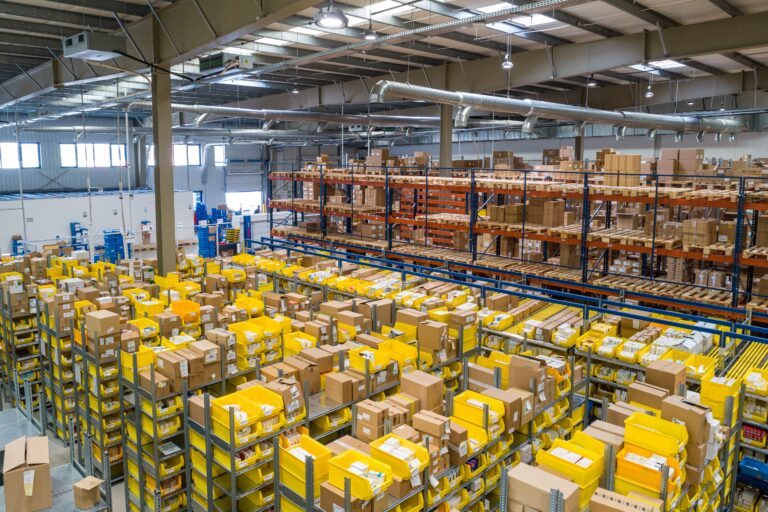
Macy’s requires that 98.5% of orders are shipped (leave the warehouse) in under 2 business days. However, the consumer expectation today is for fast, free shipping across every channel. Whether you operate from a single warehouse that you own or lease, or work with a traditional 3PL that only has 1 or 2 fulfillment centers, covering the entire country from a limited number of locations becomes extremely challenging. Additionally, with Macy’s carrier accounts, you can only pick from UPS SurePost or Ground services to fulfill orders. Imagine if your 3PL only has a California fulfillment center, but you have to ship orders to New York – customers will have to wait 4-5 business days to get their order in the era of ultrafast same or next-day delivery. With a platform like Cahoot, you can leverage a network of strategically located warehouses to place your inventory closer to your end customers and shorten delivery speeds.
Adherence to Macy’s Packing Requirements
The little things are often the most important; merchants are required to place a Macy’s branded packing slip inside every carton shipped to customers. You need a fulfillment partner that is fully aware of all these requirements and will sweat the details to ensure you are compliant with all aspects of the VDF program.
Responsive and Reliable Customer Support

As part of the VDF program, Macy’s audits and reviews the performance of Sellers in the program – any mistakes or errors that your 3PL commits directly affect your brand reputation, the Macy’s customer experience, and your ability to remain an approved vendor. It becomes essential to have a customer support team that is responsive and ready to quickly resolve any issues that you may run into.
Experience Working With Macy’s Sellers
As we mentioned before, Macy’s marketplace is curated – meaning that it’s exclusive and there are not a large number of brands or Sellers approved to participate, unlike Amazon. This therefore means there are a limited number of order fulfillment services out there that have experience working with merchants who are part of Macy Vendor Direct. Make sure to identify a company that has demonstrable social proof of its track record supporting Macy’s merchants. Here’s what one of our customers, Glo International, had to say about their experience shipping Macy’s orders with Cahoot:
“Cahoot allowed us to reduce the monthly shipping cost and the support service is really responsive and efficient!”
~ Glo International
Speak to a fulfillment expert
The Role of Logistics in Customer Satisfaction
Effective logistics and fulfillment processes are the central components to achieving success in the Macy’s marketplace. When customers place an order, they expect it to be delivered accurately and on time. Any delays or errors in the fulfillment process can lead to dissatisfaction and potentially harm the brand’s reputation and ability to continue in the VDF program. By working with a reliable 3PL provider, Macy’s vendors can ensure that their warehousing and order fulfillment processes are optimized for speed and accuracy, prioritizing early shipment and delivery wherever possible (what cahoot calls ‘preponing’, the opposite of postponing). A well-executed logistics strategy will not only meet but exceed your customer’s expectations, leading to repeat business and greater lifetime customer value.
Top Macy’s 3PL Companies
Amazon Multi-Channel Fulfillment
Amazon Multi-Channel Fulfillment (MCF) is Amazon’s outsourced fulfillment service for merchants selling on non-Amazon sales channels, such as Macy’s, whereby Amazon handles the picking, packing, and shipping of the orders coming from those sales channels. Ecommerce Sellers can store their inventory at Amazon’s warehouses, and MCF will fulfill the non-Amazon orders from select channels.
ShipBob
ShipBob is a 3PL that focuses on serving ecommerce merchants. They have a nationwide network of order fulfillment centers that enable fast shipping, but they charge extra for guaranteed 2-day shipping. Built for ecommerce, they have an easy-to-use shipping software platform and a large set of pre-built integrations.
Cahoot: The Best Macy’s 3PL
Cahoot’s order fulfillment network is built for the future of ecommerce. Our network of warehouses is strategically located at different locations in the US, enabling Macy’s merchants to offer ultrafast shipping. Our fulfillment centers are well equipped to handle all types of SKUs (including the ones that the typical Amazon fulfillment center may struggle to process) – small, lightweight, seasonal, slow-moving, heavy, and oversized.
We are also fully compliant with the Macy’s technology and packing requirements – and provide you the flexibility to use the Macy’s UPS account provided to you without any hidden fees. Lastly, our US-based customer service team is always available if something needs to be addressed, ensuring that sales are uninterrupted and that you enjoy a successful partnership with Macy’s.
|
|
 |
Traditional 3PL |
|---|---|---|
|
Compliant with Macy VDF Tech Stack |
|
|
|
Flexibility to use Macy’s UPS account |
|
|
|
Ultrafast nationwide shipping |
|
|
|
Great Customer Support |
|
|
Cahoot is committed to helping Macy’s Sellers grow their businesses with fast and affordable ecommerce order fulfillment service.
Summary
Macy’s Vendor Direct (often called Macy’s Marketplace) is Macy’s curated third-party marketplace. Launched in Fall 2022 (powered by Mirakl), it allows external sellers to list on Macy’s website and ship directly to customers. Macy’s has aggressively grown this channel to fill assortment gaps without inventory risk. At launch (Sep 2022), the marketplace gave customers access to 400 brands across 20 categories, many new to Macy’s. A Mirakl case study notes that Macy’s “added 2,000+ brands” via the new marketplace, with digital marketplace sales spiking 145% quarter-over-quarter in FY 2023. By late 2023, Macy’s reported 2,300+ brands active on its platform (the effort continues under its “A Bold New Chapter” strategy). In mid-2023, Macy’s also opened a Bloomingdale’s Marketplace (a circuit of Macy’s higher-end brand), which onboarded ~120 sellers by year-end. The company continues to invest: expanding the marketplace assortment and even integrating some products into stores, demonstrating that its marketplace has become a major growth vector.
Macy’s marketplace is invite-only/approval-only. Sellers must be vetted for brand fit and logistical readiness. The program is similar to Nordstrom’s drop-ship (Macy’s calls it Vendor Direct Fulfillment), but uses a marketplace billing model: Macy’s pays sellers after the sale (minus commission). Notably, Macy’s includes marketplace items in its Star Rewards loyalty program, incentivizing customers to buy. Sellers get access to Macy’s marketing and promotional events once active.
Table 1. Summary of the Macy’s Vendor Direct Program Requirements
|
Requirement
|
Details
|
|---|---|
|
Fees
|
No setup or monthly fees. Commission: Varies by category, typically ~15% of the sale price.
|
|
Payment Terms
|
Paid twice-monthly (the 1st and 15th of each month) for approved invoices.
|
|
Application
|
Invite-only (curated). Macy’s onboards sellers through its merchant recruitment team. Prospective sellers must meet strict brand/quality standards; selling unrelated or low-end items is unlikely to be approved.
|
|
Integration
|
Mirakl marketplace platform (via Mirakl Connect or a ChannelEngine-like partner) for catalog, plus EDI (CommerceHub) for orders/invoices. (Macy’s requires an EDI* or CommerceHub connection for order fulfillment.) Sellers must use a U.S. return address and handle all sales tax/W-9 requirements.
|
|
Shipping SLA
|
Ship complete orders within 2 business days of receiving the Macy’s PO. (Vendors must cancel any order not shipped by day 2.) Failing to ship/cancel on time can lead to cancellation. Macy’s provides a prepaid UPS account; vendors must bill all shipments to Macy’s UPS account (Ground Saver). Third-party or incorrect accounts can cause expense offsets.
|
|
Return Handling
|
Vendors accept returns directly from customers. If a customer returns an item (mail or store), the vendor must confirm receipt/return to Macy’s within 2 business days. Macy’s then credits the customer (vendors are debited the order amount). Defective or wrong-item returns may be sent directly back to the vendor (with a charge-back). Vendors must pay for return shipping.
|
|
Other Expectations
|
All shipments must include Macy’s-branded packing lists and reference numbers. Vendors must not substitute items (strict item match). Orders must ship with no aftermarket UPCs and weigh under 150 lbs. Vendors must comply with Macy’s cost-change and invoice protocols (provide Macy’s PO number on invoices). Performance is monitored monthly against on-time shipping and cancellation benchmarks; failing vendors may be suspended.
|
Invitation and Onboarding Process
Macy’s invites vendors through merchant outreach. There is no public signup form; interested sellers typically contact the Macy’s merchant team or go through a partner (e.g., an ecommerce consultant). Once engaged, Macy’s provides the Vendor Direct Fulfillment (VDF) Agreement and technical specs. Onboarding involves setting up EDI/CommerceHub for receiving orders (Macy’s sends 850 POs) and sending ASNs (856) and invoices (810). Vendors must configure Macy’s UPS account (to bill Macy’s prepaid account) and submit W-9/tax info. Mirakl is used for catalog management; vendors upload product data with Macy’s taxonomy and await SKU approval. Initial authorization is granular by category; most sellers start with a few core categories. In practice, onboarding took a few months for initial sellers: a Deloitte report noted that at launch, Macy’s marketplace offered 400 brands in 20 categories (including eight new-to-Macy’s categories). After system setup and trial orders (Macy’s often does sample orders), the vendor goes live and begins shipping real customer orders.
Common Fulfillment Pitfalls
Even established vendors can struggle with Macy’s strict requirements. Common errors include late shipments and poor PO/invoice handling. For example, if a vendor does not ship (or cancels) within 2 days, Macy’s sends a late notice and may cancel the order if unaddressed. Some vendors incur expense offsets by accidentally using a non-Macy’s UPS account. Another frequent mistake is improper labeling: every carton must contain Macy’s-branded packing slips with both order and shipment numbers; failure to include these details complicates tracking and delays payment. Returns also cause issues: vendors sometimes forget to confirm returns within 2 days, delaying customer refunds.
Support Tip: Use a partner or software with built-in Macy’s compliance, such as Cahoot. A CommerceHub or Mirakl integration will automatically generate correct packing slips and transmit PO/ASN. Establish a daily routine to check Macy’s order portal and email alerts (Macy’s sends automated notices if any EDI response is missing). Maintain inventory accuracy to avoid cancellations, and process returns quickly.
If you’d like to find out how Cahoot can help your ecommerce business, please get in touch with us. We can’t wait to show you how Macy’s order fulfillment was meant to be.

If you are selling on multiple sales channels and are interested in a 3PL that can help you with fulfillment, check out some of our other articles:
- How to Choose the Best 3PL for Your Shopify Store
- How to Choose the Best 3PL for Wayfair
- How to Choose the Best 3PL for Target Plus
- How to Choose the Best 3PL for the Nordstrom Direct Drop Ship Program
Frequently Asked Questions
What carrier does Macy’s use for shipping?
The company uses UPS and the U.S. Postal Service to deliver packages, in addition to DoorDash for same-day delivery.
What is 3PL in retail?
3PL stands for third-party logistics, also known as order fulfillment. A 3PL warehouse provides a full range of ecommerce fulfillment services, including storage, order processing, shipping, and receiving. Many 3PL warehouses provide value-added services such as returns processing, cross docking, or kitting.
How many distribution centers does Macy’s have?
Macy’s currently operates 25 fulfillment centers across the U.S. Most recently, the retailer opened a new 908,000-square-foot distribution center in Tomball, Texas in September 2023, before leasing a 272,000-square-foot facility in Lathrop, Calif. in January 2024.
What is Macy’s biggest competitor?
The main competitors of Macy’s include Dillard’s (DDS), Nordstrom (JWN), Kohl’s (KSS), JC Penney, Burlington Stores (BURL), and Target (TGT).

Turn Returns Into New Revenue

How To Choose The Best Nordstrom 3PL For Your Orders | Cahoot
In this article
 19 minutes
19 minutes
- Why is the Direct Drop Ship Program Great?
- Understanding Nordstrom’s Requirements
- What Should You Look for in a Nordstrom 3PL?
- Benefits of Working with a 3PL
- Responsive, Reliable Customer Support
- Top Nordstrom 3PL Companies
- Cahoot: The Best Nordstrom 3PL
- Bringing Cherished Stories to Life
- Summary
- Frequently Asked Questions
Nordstrom is one of the most iconic department stores in the US. Nordstrom has over 9 million shoppers each year. For most people, the first thing that comes to mind when they think of Nordstrom are its brick and mortar stores. The company serves American customers through its over 350 locations. Most ecommerce sellers might therefore ignore the retailer in pursuit of players with a larger digital presence, such as Amazon or Walmart. However, online is becoming an increasingly important part of Nordstrom’s operations – according to Statista, each year since 2020 over 35%+ of Nordstrom’s annual sales were driven through digital channels.
Nordstrom’s Direct Drop Ship program is a way for sellers to access this large segment of shoppers. Through the program, sellers can feature their product assortment on Nordstrom’s website. When customers place orders on Nordstrom, merchants must pick, pack and ship the products either from their own warehouse, or through a 3rd Party Logistics Provider (3PL) to the customer.
Before we dive into how and why you can find this 3PL partner, it’s worth asking an important question – why is the program worth doing?
Why is the Direct Drop Ship Program Great?
Nordstrom’s Direct Drop Ship Program has several powerful benefits for participating sellers:
Invite-only Marketplace Where You Can Grow Sales
Nordstrom’s Direct Drop Ship program is currently invite only – like the 3rd party marketplaces at Macy’s and Target. Nordstrom may be doing this to simplify the product assortment customers see, making it easier for them to find things they really like. For sellers, this is great because it provides access to Nordstrom customers with much less competition compared to a sales channel like Amazon, where nearly anyone can sell.
Nordstrom Provides Full Assistance With EDI Integration
Nordstrom requires transmission of information between themselves and their sellers through Electronic Data Interchange (EDI). The company does this through a CommerceHub platform called DropShip Commerce (DSCO). Whenever purchase orders are received, Nordstrom will transmit the information via EDI to the seller. Similarly, sellers must pass updates from their side (acknowledgements of Purchase Orders, Advance Shipment Notifications with tracking information etc.) through the DSCO platform.
Some retailers require the seller to take care of configuring this technology on their dropshipping programs. Nordstrom provides both the platform and assistance in integrating it with their systems.
Nordstrom Covers All Shipping Costs
One of the great advantages of the program is that shipping fees are paid for by Nordstrom. While other elements of order fulfillment, such as packaging and storage fees are still the responsibility of the seller, shipping labels are a significant cost that Nordstrom takes off their shoulders.
Sellers must make sure that they use the UPS billing account that Nordstrom provides them – so long as merchants comply with this, they will be reimbursed shipping costs across a variety of services – including Ground, 3 Day Select, 2nd Day Air and Next Day Air Saver.
Understanding Nordstrom’s Requirements
Nordstrom has specific requirements for its trading partners, including EDI compliance, timely order fulfillment, and accurate inventory management. To ensure a smooth partnership, it’s essential to understand these requirements and implement them effectively.
Trading Partner Requirements
As a trading partner with Nordstrom, you’ll need to meet certain requirements, such as:
- Timely Order Fulfillment: Nordstrom expects its trading partners to fulfill orders promptly and accurately, ensuring that customers receive their products on time. Meeting these expectations is crucial for maintaining customer satisfaction and upholding Nordstrom’s reputation for reliability.
- Accurate Inventory Management: Trading partners must maintain accurate inventory levels to prevent stockouts and overstocking. Proper inventory management helps ensure that products are always available for purchase, which is vital for keeping customers happy and maintaining a smooth supply chain.
- EDI Compliance: Nordstrom requires its trading partners to be EDI-capable, which involves exchanging electronic documents, such as purchase orders and invoices, in a standardized format. This ensures seamless communication and data exchange between Nordstrom and its partners, reducing errors and improving efficiency.
Integration Options
To integrate with Nordstrom’s systems, you’ll need to consider the following options:
Integrate with Ecommerce Platforms
Nordstrom requires its trading partners to integrate with its ecommerce platform, which involves connecting your online store to Nordstrom’s system. This integration enables you to:
- Receive Purchase Orders Electronically: By integrating with Nordstrom’s ecommerce platform, you can receive purchase orders directly into your system, streamlining the order processing workflow and reducing manual data entry.
- Send Shipment Notifications and Tracking Information: Integration allows you to send shipment notifications and tracking information to Nordstrom automatically. This ensures that customers are kept informed about the status of their orders, enhancing their shopping experience.
- Update Inventory Levels in Real-Time: Real-time inventory updates help you maintain accurate stock levels, preventing overselling and stockouts. This integration ensures that Nordstrom always has up-to-date information about your inventory, which is crucial for maintaining a smooth supply chain.
By integrating with Nordstrom’s ecommerce platform, you can improve the efficiency of your order fulfillment process and ensure that you meet Nordstrom’s requirements. This seamless connection helps you provide a better customer experience and maintain a strong partnership with Nordstrom.
What Should You Look for in a Nordstrom 3PL?
Due to Nordstrom’s stringent requirements, many sellers find it simpler and more profitable to rely on an established 3PL that is already familiar with and comfortable meeting Nordstrom’s requirements. This way sellers can reap the benefits of participating in Nordstrom’s Direct Drop Ship program without having to completely retool their inventory storage and order workflows.
Maintain a Fulfillment Rate of 98%

Nordstrom requires that sellers keep cancellations extremely low – 98% of orders must be fulfilled before the defined due date on the DSCO system.
Traditional 3PLs that operate with a single warehouse location may not be ideal – in the event of any disruption at that location (extreme weather, carrier services disruption etc.), your ability to ship products on time to customers will be impacted.
Additionally, traditional 3PLs may be limited to basic spreadsheets or worse, manual bookkeeping to keep track of your inventory. If you run out of stock and purchase orders continue flowing in, you will be forced to cancel them, affecting your fulfillment rate metrics. Cahoot’s software intelligently decrements the count of inventory as it leaves our warehouses and provides color-coded alerts to you on a dashboard so that you always replenish products in time to keep your sales going.
Ability to Ship 97% of Orders On-Time
Nordstrom defines its shipping SLAs based on whether the order requires Standard or Expedited Shipping.
Achieving this high level of performance comes down to ensuring that your fulfillment partner has excellent pick/pack and order fulfillment practices to get every order out within time.
Make sure to conduct extensive research into the standards at your 3PL’s warehouse. On Cahoot’s order fulfillment network, warehouses must pass a 44-point checklist to be eligible to fulfill orders for our sellers.
|
Level of Service |
SLA for Shipping |
|---|---|
|
Ground |
1 business day |
|
3 Day Select |
1 business day |
|
2nd Day Air (PO received before 12 PM PST) |
Same Day |
|
2nd Day Air (PO Received after 12 PM PST) |
1 business day |
|
Next Day Air Saver (PO received before 12 PM PST) |
Same Day |
|
Next Day Air Saver (PO received after 12 PM PST) |
1 business day |
“The Cahoot team have been great to work with — always trying to provide great service and address any concerns and issues quickly and effectively. We’ve been very impressed with their shipping performance and communication on status of delivery for packages.”
~ Fenix Light Store
Speak to a fulfillment expert
Have an Existing UPS Account, and Experience Working With the Carrier
Nordstrom requires that sellers ship all Nordstrom orders on their own UPS account, which is connected to your, or your 3PL’s UPS account. In order to meet Nordstrom’s fulfillment metrics, your 3PL must have experience working with UPS to ensure that daily pickups and carrier scans are conducted in a timely fashion, thereby streamlining your Nordstrom order fulfillment.
Help You Meet Nordstrom’s Eco-Friendly Packaging Standards
In Nordstrom’s words, they ‘strive to be an environmentally friendly company’. They also encourage sellers to avoid excess packaging.
With many traditional 3PLs, you may find that items often ship in boxes larger than the SKU actually needs. The problem is that most traditional 3PLs have a very limited configuration of boxes of standard sizes. Items are simply thrown into the next available box, without taking care to identify if it is truly the most optimal one.
The problem worsens with Multi-Line, Multi-Quantity (MLMQ) Orders. These orders can often be unnecessarily split into multiple boxes. With Cahoot’s MLMQ automation features, our system learns from SKU and box dimension data, as well as past data to intelligently identify the most optimal box for every order.
This ensures that you save costs across every order, while also meeting Nordstrom’s (and the customer’s) expectation for more environmentally responsible, sustainable packaging.
Fully Compliant With Nordstrom Packing Slip Requirements
Nordstrom requires every shipment sent to customers to have a branded packing slip, as well as a return label (Nordstrom bears all shipping costs).
This is an example of what a Nordstrom packing slip looks like:
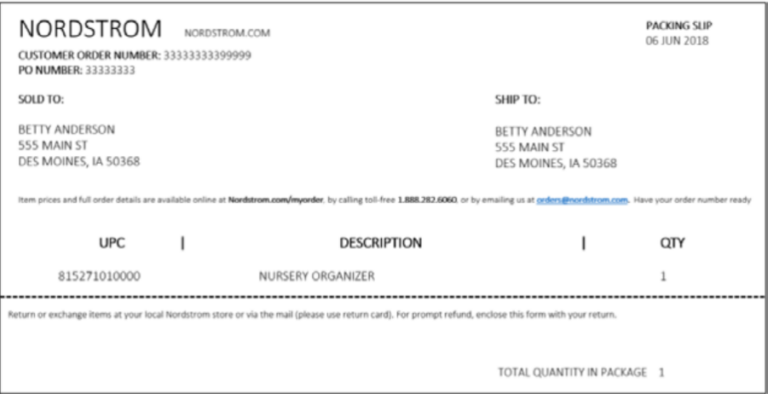
This is what a Nordstrom return label looks like:
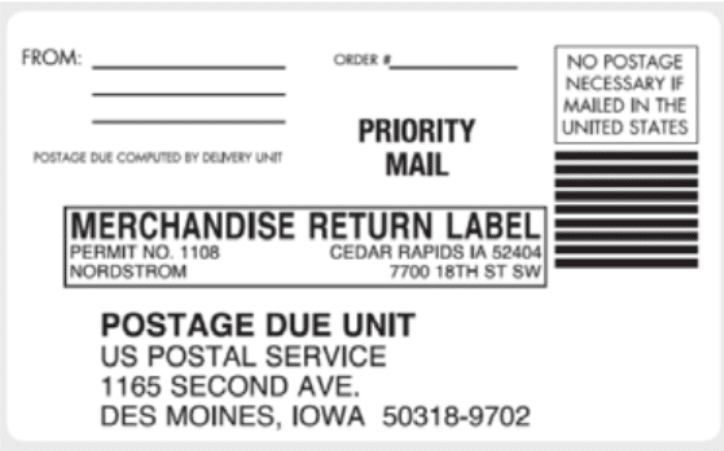
Your 3PL fulfillment partner must sweat the details and ensure that all of these requirements are complied with – the little things matter enormously toward ensuring both continued enrollment in the Direct Drop Ship program, as well as customer satisfaction.
Fully Compliant with Nordstrom EDI Technology
The 3PL must be able to work with the Direct Drop Ship Program’s tech stack (DSCO platform) and ensure that you comply with all the requirements around data transmission to Nordstrom.
Benefits of Working with a 3PL
Working with a third-party logistics (3PL) provider can help you meet Nordstrom’s requirements and improve your overall business operations. Some benefits of working with a 3PL include:
- Improved Order Fulfillment: 3PLs specialize in order fulfillment and can help you meet Nordstrom’s timely fulfillment requirements. Their expertise in logistics ensures that orders are processed and shipped efficiently, reducing the risk of delays and errors.
- Enhanced Inventory Management: 3PLs can help you manage your inventory levels more effectively, reducing the risk of stockouts and overstocking. With advanced inventory management systems, 3PLs provide real-time visibility into your stock levels, helping you make informed decisions about replenishment and stock allocation.
- Increased Efficiency: 3PLs can streamline your logistics operations, freeing up time and resources for you to focus on growing your business. By outsourcing logistics to a 3PL, you can concentrate on core business activities such as marketing, product development, and customer service.
Responsive, Reliable Customer Support

Order fulfillment is a complex operation, involving multiple, intricate steps in the process from click to delivery. Things don’t always go as planned, but what is crucial is ensuring that your 3PL has a responsive, reliable customer support team whom you can rely on to fix problems fast, with minimal disruption to your business operations.
Experience Working with Nordstrom Sellers
Most traditional 3PLs may not have personnel with the experience and expertise working with Nordstrom to troubleshoot and fix problems fast – costing you precious time and sales. It is important to identify a Nordstrom fulfillment partner with a reliable, responsive customer support team – who will be ready to dive in and solve problems quickly, so that you’re always selling and keeping your customers happy.
Here’s what one of our customers had to say about Cahoot’s Support team:
Cahoot’s support is prompt and personal, not monolithic and apathetic as some large companies tend to be. Cahoot is not only a great 3PL provider but also a strategic partner that goes above and beyond for its clients. They are a 5-star team of people who make it their business to care about yours.”
~ VERSACART
Speak to a fulfillment expert
So now that we’ve taken a look at the important criteria that guide your choice of a 3PL for Nordstrom, let’s look at the options that are actually available to you, and the pros and cons of each of them:
Top Nordstrom 3PL Companies
Amazon Multi-Channel Fulfillment
Amazon Multi-Channel Fulfillment (MCF) is Amazon’s outsourced fulfillment service for merchants selling on non-Amazon sales channels, such as Nordstrom, whereby Amazon handles the picking, packing, and shipping of the orders coming from those sales channels.
Ecommerce sellers can store their inventory at Amazon’s warehouses, and MCF will fulfill the non-Amazon orders from select channels. MCF deploys the same infrastructure and resources that power Amazon’s in-house Fulfilled By Amazon (FBA) logistics network.
ShipBob
ShipBob is a 3PL that focuses on serving ecommerce merchants. They have a nationwide network of order fulfillment centers that enable fast shipping, but they charge extra for guaranteed 2-day shipping. Built for ecommerce, they have an easy-to-use shipping software platform and a large set of pre-built integrations.
Cahoot: The Best Nordstrom 3PL
Cahoot is committed to helping Nordstrom sellers grow their businesses with fast and affordable ecommerce order fulfillment services.
Cahoot’s peer-to-peer order fulfillment network is built for the future of ecommerce. Our network of warehouses is located at strategic locations across the US, enabling Nordstrom Direct Drop Ship merchants to offer their customers ultrafast shipping. Our fulfillment centers are well equipped to handle all types of SKUs (including the ones that the typical Amazon Fulfillment Center may struggle to process) – small, lightweight, seasonal, slow-moving, heavy, and oversized.
We are compliant with all aspects of the Nordstrom Direct Drop Ship program – and provide you the flexibility to use the Nordstrom UPS account provided to you without any hidden fees. Our US-based customer service team is always available if something needs to be addressed, ensuring that sales are uninterrupted and that you enjoy a successful partnership with Nordstrom.
Bringing Cherished Stories to Life
Growth is a good problem to have – but how do you make sure it doesn’t bury you?
Cali’s Books creates and sells innovative children’s books that bring stories to life with interactive sounds and songs. What started as a dedicated mom working out of her garage has grown to an organization of colleagues around the world producing hundreds of unique books and fulfilling tens of thousands of orders each month.
Cali’s growth has taken off in diverse channels: Amazon, their Shopify store, and retailers like Nordstrom. Before Cahoot, they relied on a complex fulfillment strategy with multiple different partners to try to fulfill orders across their different channels.
Summary
Nordstrom’s Direct Drop Ship program is an invite-only channel that lets select vendors list products on Nordstrom.com and ship directly to customers. It is highly curated and supported; vendors need strong brand fit and logistics to qualify.
Table 1. Summary of the Nordstrom Drop Ship Program Requirements
|
Requirement
|
Details
|
|---|---|
|
Fees & Commissions
|
No setup, listing or transaction fees. Vendors sell to Nordstrom at wholesale cost (Nordstrom retains retail margin), so there is no marketplace commission per se.
|
|
Application
|
Invite-only – Nordstrom buyers hand-pick brands and expand the assortment carefully. There is no open signup; sellers typically enter via buyer relationships or referrals. (Historical notes suggest Nordstrom holds kickoff calls once invited.)
|
|
Technical Integration
|
Mandatory EDI/API via Dsco (e.g., CommerceHub DropShip Commerce). Nordstrom provides the DSCO platform and assists with setup. Vendors must connect inventory and orders via EDI/CSV/XML through DSCO. (No published public API.)
|
|
Order SLAs
|
Ship within 1 business day of order (orders placed by noon PST should ship same day; others by next day). Vendors must confirm shipment and invoice (via DSCO) on the ship date (within 1 day). Nordstrom pays UPS Ground/2nd Day Air; use Nordstrom’s UPS account. Nordstrom imposes no late-shipment or cancellation fees provided the vendor cancels in time.
|
|
Return Handling
|
All customer returns go to Nordstrom’s fulfillment center (Cedar Rapids) and are processed by Nordstrom. Vendors must accept returns of resalable and defective merchandise and issue credit invoices to Nordstrom. Vendors may apply a restocking fee (up to ~$2.50 per item) for resalable returns. Defects are handled per Nordstrom agreements (or case-by-case).
|
|
Other Ops Expectations
|
Unbranded packaging/labels only; no marketing inserts. Vendors must have a dedicated customer support line during North American business hours (Nordstrom Drop Ship Ops, M–F 9 am–5 pm PST). Gift-wrap or Nordstrom-branded packaging is optional (Nordstrom pays only carrier shipping).
|
Invitation and Onboarding Process
Nordstrom does not accept unsolicited sign-ups: new sellers join only by invitation from the Nordstrom buying team or merchant development group. Ideal candidates have strong brand recognition or a unique assortment that fits Nordstrom’s curation. In practice, Nordstrom will meet with a vendor (or 3PL) to review operations and the catalog. Once invited, the vendor signs a drop-ship agreement, provides required documents (U.S. business tax ID, W-9, etc.), and connects via the provided DSCO (CommerceHub) account. Nordstrom supports vendors through the EDI onboarding (often via a 3PL or system integrator). After DSCO integration, vendors load item data (UPC-based inventory), learn Nordstrom’s fulfillment requirements, and gradually activate SKUs on the site. The approval timeline is vendor-specific, but DSCO integration and system validation typically take 4–12 weeks for a completed setup.
Public accounts are scarce, but industry reports highlight Nordstrom’s emphasis on quality and its flexible integration. For example, Nordstrom adopted the Dsco/CommerceHub platform to streamline onboarding – one case study noted an onboarding rate of ~40 vendors/month (a 4× productivity increase) once DSCO was in place. Retail sources confirm Nordstrom covers all shipping fees (so sellers ship via Nordstrom’s UPS account) and imposes no late-shipment penalties.
Growth (2022–2025)
Nordstrom’s drop-ship channel remains much smaller than Amazon’s or Walmart’s. The company does not publicly report vendor counts. However, insiders note steady growth: by using DSCO, Nordstrom accelerated onboarding (one report cited a 4× increase in speed). Nordstrom executives have said drop-ship suppliers tend to increase overall buying from vendors rather than cannibalize sales. In practice, Nordstrom carefully adds only dozens of new vendors per year to keep the assortment curated. In summary, while Nordstrom’s digital sales are growing (>35% of sales online), the invite-only drop-ship program has expanded cautiously, focusing on apparel, shoes, and home categories without rampant expansion.
Common Fulfillment Pitfalls
New Nordstrom drop-shippers often falter on timeliness and compliance. Failing to ship within 1 day or to cancel unshippable orders promptly will lead to order cancellations (Nordstrom will cancel and not pay for late shipments). Other common issues include using the wrong shipping account (vendors must use Nordstrom’s UPS account to get paid), submitting invoices late, or incorrectly mapping items (SKU mismatches lead to payment delays). Vendors must carefully follow Nordstrom’s SKU/UPC data requirements and DSCO transaction formats. Return handling can also trip up sellers as Nordstrom only provides a single Return Authorization (RA) number for drop-ship returns, so vendors should have processes to handle returns without individual RAs.
Support Tip: Integrate with Nordstrom’s DSCO early and engage Nordstrom Drop Ship Operations if any order goes awry. Confirm all POs via DSCO (997 EDI) and ship notices quickly. Keep a live point of contact with Nordstrom’s team during onboarding. Some sellers have found that working through Nordstrom-approved 3PL partners (like Cahoot) simplifies DSCO integration and ensures compliance with Nordstrom’s gift-wrap and packing requirements. If you’d like to find out how Cahoot can help your ecommerce business, please get in touch with us. We can’t wait to show you how Nordstrom order fulfillment was meant to be.
If you’d like to find out how Cahoot can help your ecommerce business, please get in touch with us. We can’t wait to show you how Nordstrom order fulfillment was meant to be.

If you are selling on multiple sales channels and are interested in 3PLs that can help you with fulfillment, you can read our other articles:
- How to Choose the Best 3PL for Your Shopify Store
- How to Choose the best 3PL for Your Macy’s Orders
- How to Choose the Best 3PL for Target Plus
- How to Choose the Best 3PL for Wayfair
Frequently Asked Questions
What is Nordstrom’s Direct Drop Ship Program?
Nordstrom’s Direct Drop Ship Program allows vendors to ship products directly to Nordstrom customers, bypassing Nordstrom’s warehouses. This program enables Nordstrom to expand its product offerings without holding inventory, while vendors like you manage fulfillment and shipping while meeting Nordstrom’s strict compliance standards.
What carrier does Nordstrom use for shipping?
Nordstrom requires sellers to use their own UPS account for all Nordstrom orders.
What is a 3PL?
3PL stands for third-party logistics, also known as order fulfillment. A 3PL warehouse provides a full range of ecommerce fulfillment services, including storage, order processing, shipping, and receiving. Many 3PL warehouses provide value-added services such as returns processing, cross docking, or kitting.
How many distribution centers does Nordstrom have?
Nordstrom currently operates over 350 stores across the U.S. These stores also fulfill online orders and act as shipping locations. In addition, each seller participating in Nordstrom’s Drop Ship Program also can act as a distributor for orders placed on Nordstrom.
What is Nordstrom’s biggest competitor?
The main competitors of Nordstrom (JWN) include Dillard’s (DDS), Macy’s (M), Neiman Marcus (private), and Saks Fifth Avenue (SKS).

Turn Returns Into New Revenue




